10 – Use it or lose it
What do redstarts really sound like?
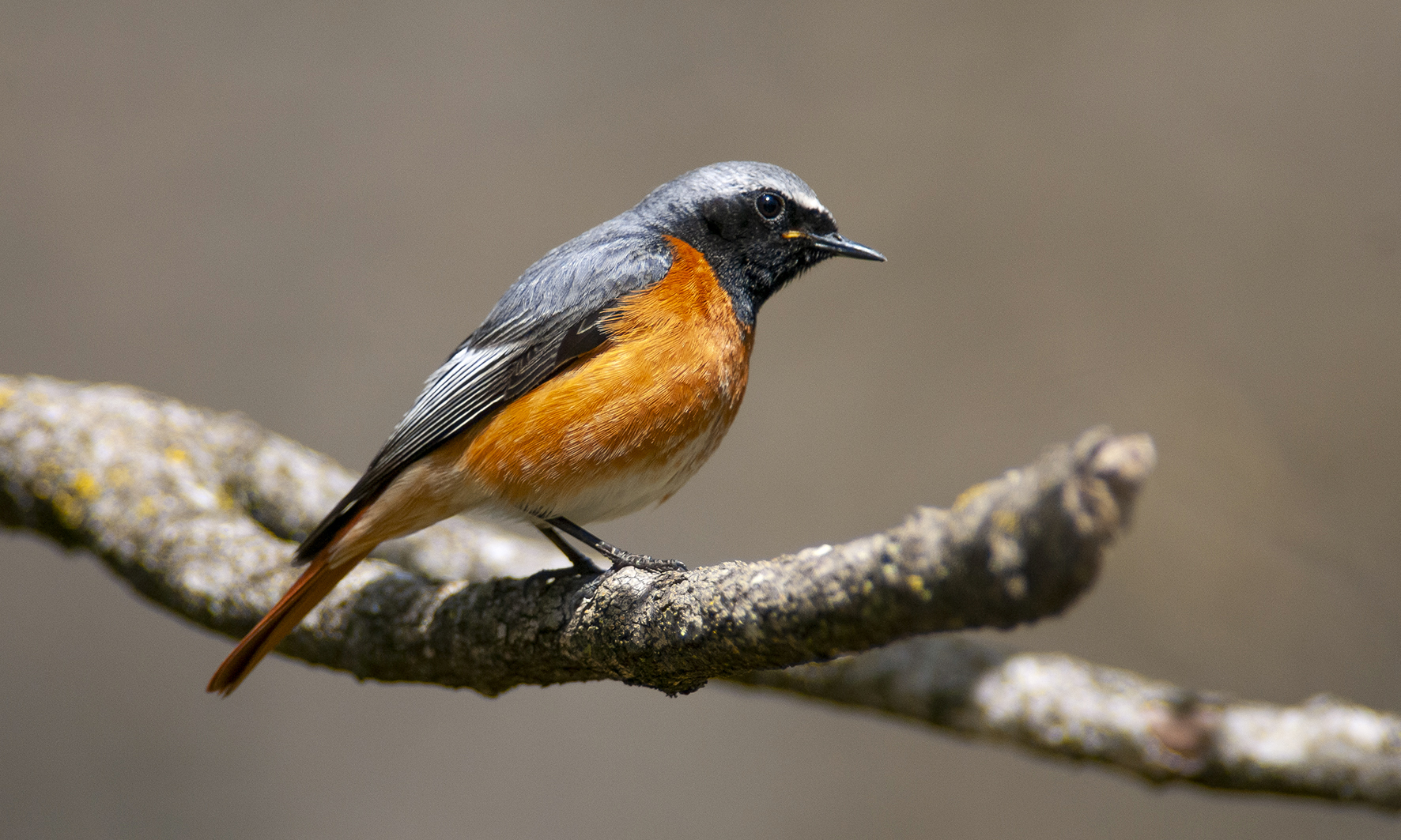
Ehrenberg’s Redstart Phoenicurus phoenicurus samamisicus Dilijan, Armenia, 2 May 2011 (René Pop).
“It’s a strange irony that as we get older, while the physical side of our sound perception deteriorates, our powers of discrimination, our mental processing of the data, seems to improve. There’s no doubt that sensitivity to higher frequency sound diminishes with age. Having just passed 50, I find that the Roesel’s Bush cricket I recorded over 10 years ago, is no longer the loud buzz I remember, but a faint rather insubstantial hissing buzz. I have friends a decade or two ahead of me, who are now struggling to hear or have lost Goldcrest calls (some of the highest-pitched birdcalls). But at the same time I can now hear clear differences in some distinctions I struggled with in the past, to the point that I wonder how I couldn’t hear it before. Experience must build on our powers of recognition and discrimination. It’s a very satisfying thing the interpretive power built on an age of experience. That goes some way in compensating for the waning physical capabilities and I’m thankful for it.”
Geoff Sample p.17 Collins Field Guide to Wildlife Sounds
Geoff published a series of Collins bird sound guides from 1996 to 2010 in a pre-Xeno-canto era, and the lovely little book cited above in 2006. I lost my high frequency hearing so long ago, when it was considered OK for adults to routinely hit a boy around the head. So my hearing didn’t even make it to my first rock concert. My birding friends know this. I remember Arnoud and Bruce MacTavish in New Jersey staring into a scruffy patch of long grass as they pretended to hear the high-pitched song of Grasshopper Sparrow Ammodramus savannarum, all the time asking me what I thought of it. In Arnoud’s memory I did seem to hear something. I’m sure I didn’t.
Grasshopper Sparrow Ammodramus savannarum Frank Lake, Alberta, Canada, 14 June 2003 (Arnoud B van den Berg). Song of a male. Background: Killdeer Charadrius vociferus, California Gull Larus californicus and Savannah Sparrow Passerculus sandwichensis. 03.027.AB.14611.01
Arnoud, Mo, Cecilia and I have been to a few music concerts together, with real singers this time… Gregory Porter was great, then another evening we went to see Taraf de Haïdouks, 20 traditional Romanian musicians who improvised together. Sitting up in the circus-like gallery of Paradiso in Amsterdam I noticed Arnoud had put in earplugs. Not like him to pay good money to go to a concert only to block out part of the sound. They started playing and it was loud.
At the concert’s end the heaving crowds pushed down the aisles. Arnoud and I had come down different staircases. There in the foyer the band were playing us out, each instrument like a golden island in the sea of Dutch faces. I must admit to a little Schadenfreude when I saw Arnoud sans earplugs, with his head almost inside a huge tuba being played at full volume.
When we protect our hearing from damage, research shows that many of us actually keep good hearing into our eighties. The same research shows that musicians and, one hopes, bird sound recordists, seem to keep better hearing longer (Zendel & Alain 2011). Use it or lose it.
My own attitude towards losing hearing through ageing mirrors Dylan Thomas’s famous poem. When his father was going blind he wrote:
Do not go gentle into that good night,
Old age should burn and rave at close of day;
Rage, rage against the dying of the light.
For the older birder like Arnoud or me the paranoid fear of losing our hearing linked to the sound blindness of poor perception deserves a poem all of its own. Despite such worries we have both learnt that losing a bird sound is a matter of distance and amplification. We can hear most bird sounds once recorded, and the amplification of a couple of mics linked to a recorder and earphones more than compensates for any inadequacy of our hearing.
What do I mean by “sound blindness”? At the risk of losing all credibility I remember one of my darker birding hours and shudder.
I was again with Bruce MacTavish and we were at Skala Kalloni, Lesvos, in some sheep fields bordering salt pans. A Rufous-tailed Scrub Robin Cercotrichas galactotes was singing on territory. Excitedly I had rolled out 20 metres of cables and was sitting back with Bruce and a group of random birders. Something was wrong. I couldn’t hear it through the earphones. I could see it. Singing. I should have been recording. I plugged and unplugged the earphones, twiddled the various knobs and controls. Despite not really trusting him, in desperation I handed the earphones to Bruce…
“Yep, I can hear it.”
I snatched them back. Nothing. Was this more mischief?
“Are you sure?” I asked. He took them back: “Yep”.
I tried again and slowly it dawned. When I listened carefully I could hear a far too familiar song of European Robin Erithacus rubecula…
My elder son would, for fun, constantly repeat “Dad”, “Dad”, “Dad”, ”Dad”, and then having got no reaction would suddenly say “Mark”. I would sit up and he would laugh. I had during the course of three kids learnt to shut out the word “Dad”. Discriminating in what I heard however, had caught me out this time. It’s only now when I again actively listen to my recording that it sounds far less like a European Robin.
Eastern Rufous-tailed Scrub Robin Cercotrichas galactotes syriaca Skala Kalloni, Lesvos, Greece, 5 May 2007 (Mark Constantine). Song of a male. Background: Crested Lark Galerida cristata, Greater Short-toed Lark Calandrella brachydactyla, Black-headed Wagtail Motacilla feldegg and Corn Bunting Emberiza calandra. 07.010.MC.05600.02
Why don’t we hear things that are clearly making a noise? Birders are always going on about whether they can still hear a Firecrest Regulus ignicapilla or a Goldcrest R regulus, and while I could explain more about that I find it far more interesting to ask, what other sounds are we missing that we are hearing but not actively registering?
The RSPB brought out a new guide to bird song just at the beginning of lockdown, written by Adrian Thomas (2020). It’s very nice. In it he points out that for example the song of Common Redstart Phoenicurus phoenicurus could, at first, be dismissed as a Common Chaffinch Fringilla coelebs. There’s a thought. Could I be dismissing redstart’s song as a chaffinch?
I can remember when listening properly to a bird in the New Forest, Hampshire in 2012, writing that it had a song like a Common Chaffinch Fringilla coelebs, so not out of my hearing range. And yet I suspect I am doing the robin thing again, but this time dismissing it as a chaffinch purely out of stupidity. Have a listen.
Common Redstart Phoenicurus phoenicurus New Forest, Hampshire, England, 08:52, 13 April 2009 (Mark Constantine). Song of an adult male, with imitations including White-throated Bee-eater Merops albicollis. Also, some huit-plit-plit calls. Background: Canada Goose Branta canadensis, Western Jackdaw Corvus monedula, Song Thrush Turdus philomela, European Robin Erithacus rubecula, Common Chiffchaff Phylloscopus collybita and Common Firecrest Regulus ignicapilla. 090413.MC.085200.11
Walking yesterday with a kinder friend, Ian Lewington, while worrying about the collapse in Britain of breeding chaffinches I asked him if he had noticed many singing.
” I tend to screen chaffinch songs out while listening for songs I don’t know.” He said.
Aha, there it is again. Not just me and Adrian then having this benign, unconscious bias. I asked him if he thought he missed songs of Common Redstart as a consequence.
He pondered. “Common Redstart’s song would certainly make my ears prick up… they might be like Common Chaffinch to you but not to me”. Hmmm.
So without further ado, let’s look at and listen to the redstarts. Appearance first though. Here are some helpful illustrations from Killian Mullarney and Richard Johnson.
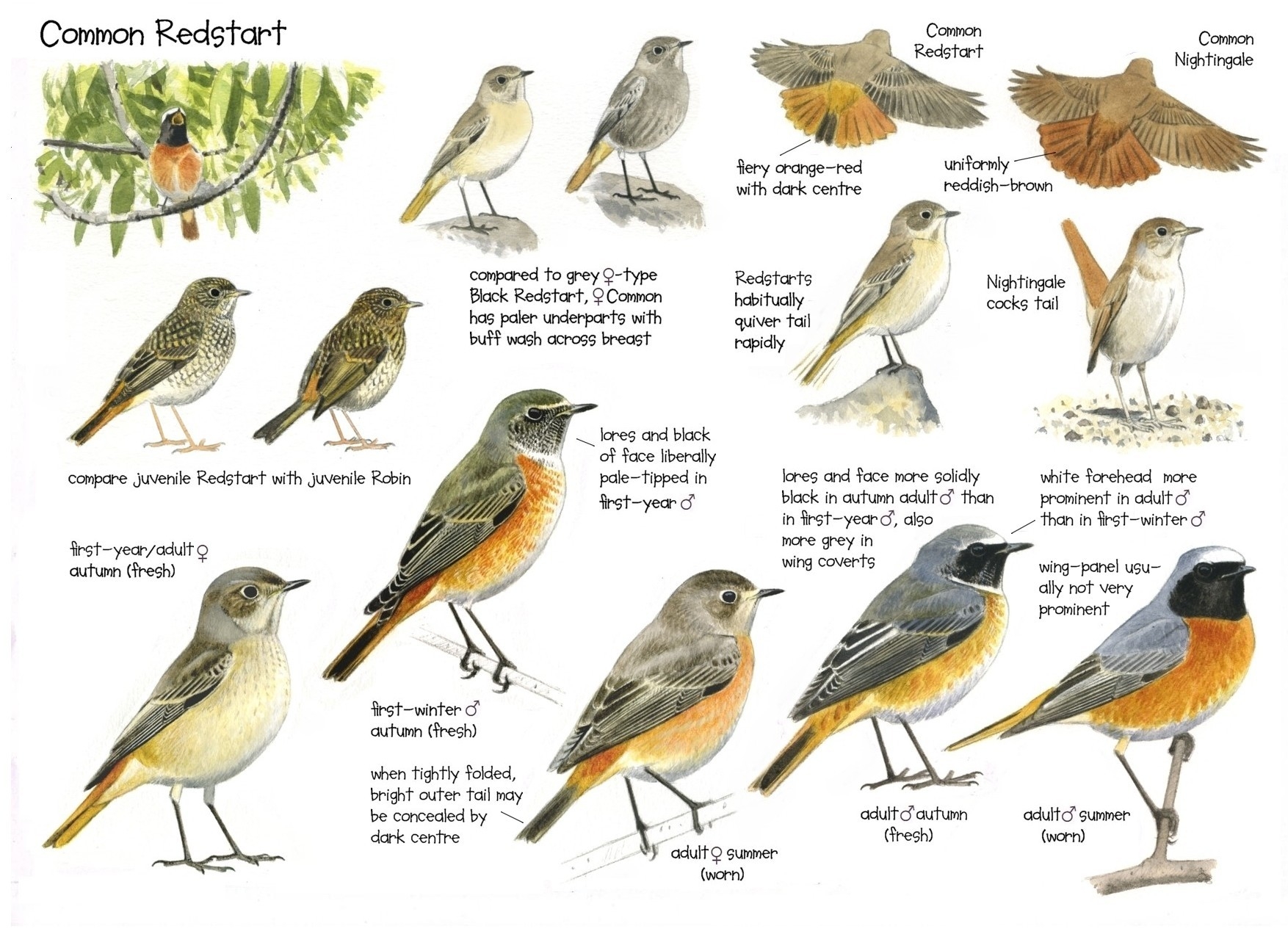
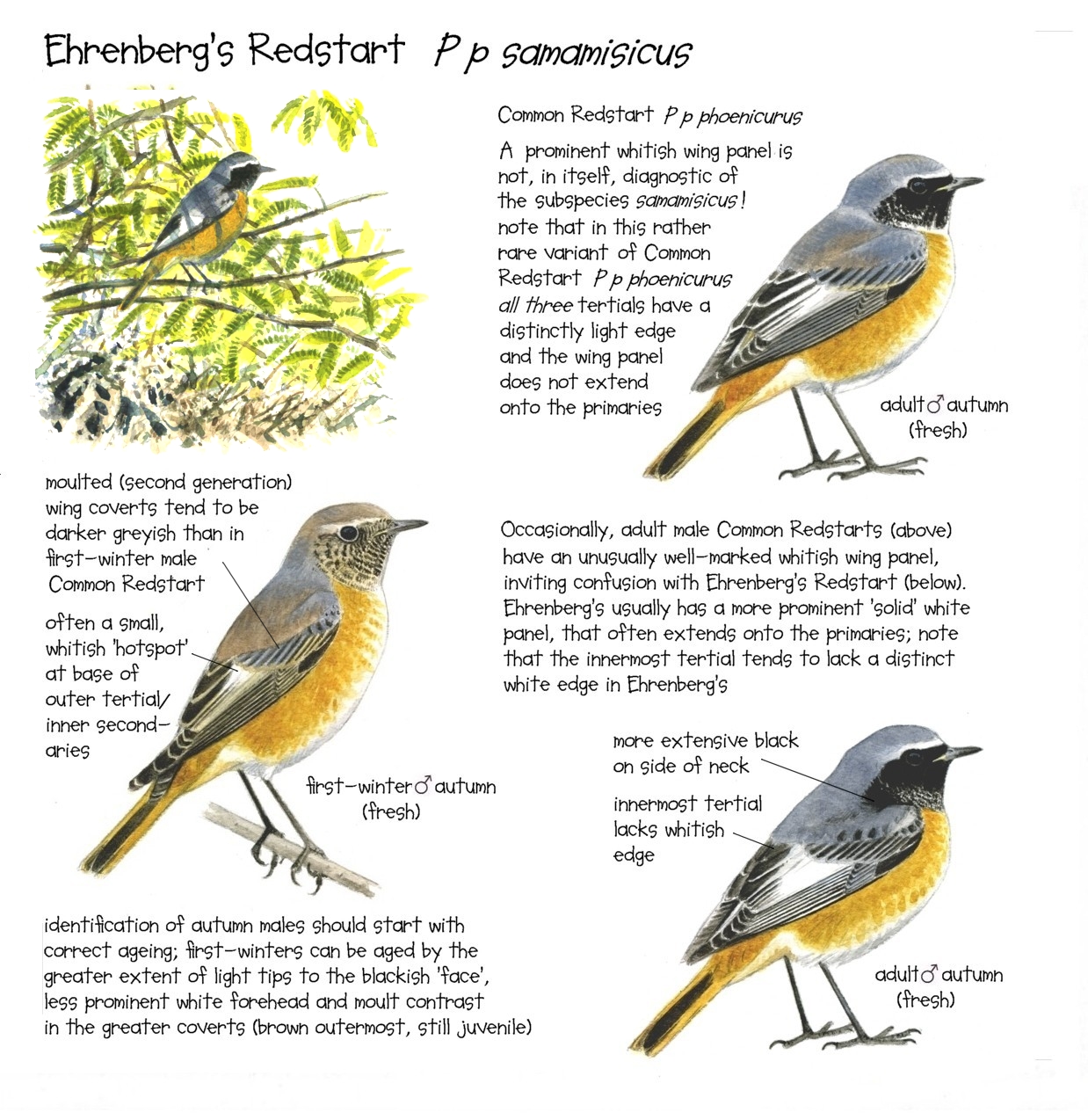
Common Redstart has a brilliant song, but does it sing like a Common Chaffinch, Magnus?
Common Redstart Phoenicurus phoenicurus phoenicurus
Well, Mark, that comparison would never have occurred to me, but it’s true that they sing in a similar pitch range and have strophes of a similar length. A reliable and simple way to recognise a Common Redstart song is that it tends to start with a few notes in a stereotypical pattern. Usually the first is a whistle and the few that follow are a slightly harsher sound. Together they sound like a little fanfare to get things going. If you like dodgy mnemonics, the bird could be singing “Here’s what I heard….” since what follows is a string of imitations of other birds, local or from any location on the bird’s annual journey. Common Redstart is one of our best mimics as indeed a couple of other studies have already illustrated (eg, Comolet-Tirman 1994, Schreur et al 2020).
Here is a Common Redstart singing in a forest in Lapland where bird densities are very low, and the next singer may be another redstart 200 m away. He mimics local breeders such as Wood Sandpiper Tringa glareola, Spotted Redshank T erythropus, Siberian Jay Perisoreus infaustus, Bohemian Waxwing Bombycilla garrulus and Pine Grosbeak Pinicola enucleator, as well as a tundra breeder that will have passed overhead while migrating further north: Lapland Longspur Calcarius lapponicus. Then there are European species that don’t breed so far north, such as Green Woodpecker Picus viridis, Eurasian Scops Owl Otus scops and European Serin Serinus serinus, which he presumably heard while passing through the continent. His African wintering area is represented by Little Weaver Ploceus luteolus (a common species in the Sahel), Green Bee-eater Merops orientalis (Middle East and the Sahel) and Blue-cheeked Bee-eater M persicus (breeds in North Africa and the Middle East; winters in the Sahel).
Common Redstart Phoenicurus phoenicurus Viikusjärvi, Norrbotten, Sweden, 12 June 2015 (Magnus Robb). Song with imitations of birds from Lapland, further south in Europe, and Africa or the Middle East. Background: Spotted Redshank Tringa erythropus. 150612.MR.212658.00
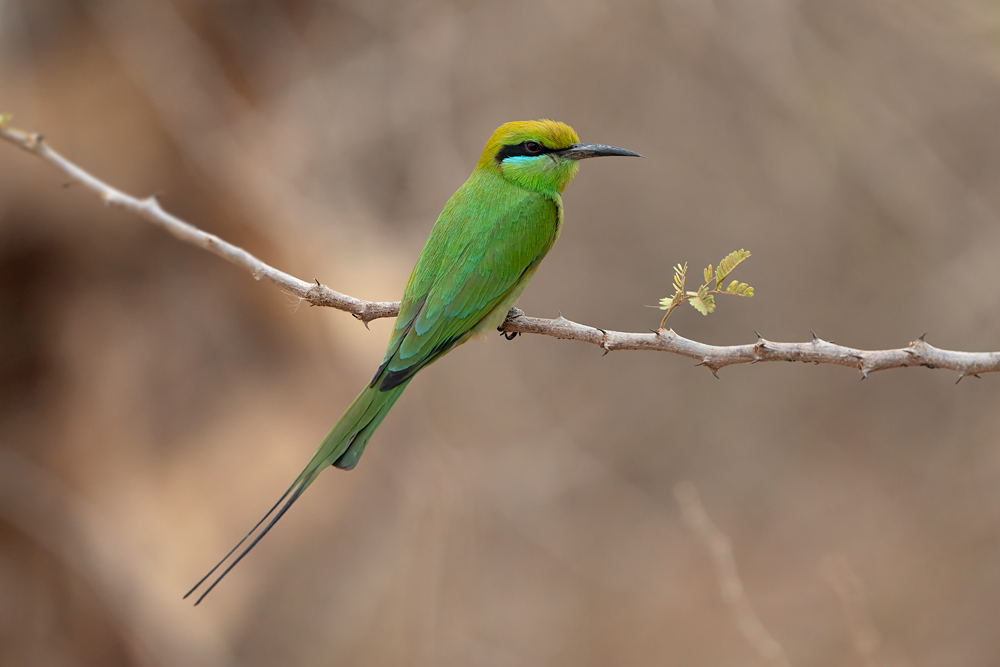
Green Bee-eater Merops orientalis viridissimus Richard Toll, Saint-Louis, Senegal, 25 February 2020 (Dick Forsman).

Pine Grosbeak Pinicola enucleator Uppsala, Uppland, Sweden, 21 November 2004 (René Pop).
Green Bee-eater Merops orientalis beludschicus Jaisalmer, Rajashan, India, 23 January 2002 (Magnus Robb). Calls pretty similar to those of Sahel subspecies veridissimus, despite sometimes being regarded as a different a different species. Background: Common Babbler Turdoides caudatus. 02.005.MR.00334.02
Pine Grosbeak Pinicola enucleator Tuolpukka, Norrbotten, Sweden, 13 June 2015 (Magnus Robb). Simple song of a first summer male or female. Background: Willow Warbler Phylloscopus trochilus. 150613.MR.005938.00
It is worth listening to the entire 12 minutes of this Common Redstart recording, so you can appreciate the full range of imitations in the song. Besides, it is a very beautiful song. I have picked out 39 species that I can recognise, though there must undoubtedly be more, especially from Africa given that I am much less familiar with sounds from there. Here is what I could find:
| Common Teal | Anas crecca |
| European Nightjar | Caprimulgus europaeus |
| Green Sandpiper | Tringa ochropus |
| Spotted Redshank | Tringa erythropus |
| Wood Sandpiper | Tringa glareola |
| Common Redshank | Tringa totanus |
| Green Bee-eater | Merops orientalis |
| Blue-cheeked Bee-eater | Merops persicus |
| Eurasian Scops Owl | Otus scops |
| European Green Woodpecker | Picus viridis |
| Great Spotted Woodpecker | Dendrocopos major |
| Siberian Jay | Perisoreus infaustus |
| Eurasian Blue Tit | Cyanistes caeruleus |
| European Crested Tit | Lophophanes cristatus |
| Eurasian Coal Tit | Periparus ater |
| Willow Tit | Poecile montanus |
| Woodlark | Lullula arborea |
| Red-rumped Swallow | Cecropis daurica |
| Long-tailed Tit | Aegithalos caudatus |
| Bohemian Waxwing | Bombycilla garrulus |
| Eurasian Nuthatch | Sitta europaea |
| Common Treecreeper | Certhia familiaris |
| Eurasian Wren | Nannus troglodytes |
| Redwing | Turdus iliacus |
| Spotted Flycatcher | Muscicapa striata |
| European Pied Flycatcher | Ficedula hypoleuca |
| Dunnock | Prunella modularis |
| House Sparrow | Passer domesticus |
| Little Weaver | Ploceus luteolus |
| Grey Wagtail | Motacilla cinerea |
| Tree Pipit | Anthus trivialis |
| Pine Grosbeak | Pinicola enucleator |
| Northern Bullfinch | Pyrrhula pyrrhula pyrrhula |
| European Greenfinch | Chloris chloris |
| Mealy Redpoll | Acanthis flammea |
| Common Crossbill | Loxia curvirostra |
| Parrot Crossbill | Loxia pytyopsittacus |
| European Serin | Serinus serinus |
| Lapland Longspur | Calcarius lapponicus |
| Yellowhammer | Emberiza citrinella |
If you go to the other end of Common Redstart’s European breeding range, in southern Portugal, its songs are very similar in structure, but the range of species imitated is rather different, reflecting the Iberian avifauna. Perhaps this may convince some sceptics who believe the resemblances to be merely coincidental.
Let’s take a Common Redstart I recorded shortly after it arrived in Portugal this spring. Its imitative range includes mostly local species such as Red-legged Partridge Alectoris rufa, Pallid Swift Apus pallidus, Eurasian Magpie Pica pica, European Crested Tit Lophophanes cristatus, Woodlark Lullula arborea, Thekla’s Lark Galerida theklae, Sand Martin Riparia riparia, Long-tailed Tit Aegithalos caudatus, Western Bonelli’s Warbler Phylloscopus bonelli, Sardinian Warbler Sylvia melanocephala, Eurasian Nuthatch Sitta europaea, Short-toed Treecreeper Certhia brachydactyla, Eurasian Wren Nannus troglodytes and European Serin Serinus serinus. An imitation of Meadow Pipit Anthus pratensis is remarkable as there is barely any overlap in presence between the wintering pipit and the summering redstart. As for Africa, again it is represented by Green Bee-eater Merops orientalis. This is a fairly short recording; a longer excerpt would contain mimicry of many more species.
Common Redstart Phoenicurus phoenicurus Courelinhas, Coruche, Portugal, 09:57, 7 April 2021 (Magnus Robb). Song of an unpaired male. Background: Eurasian Collared Dove Streptopelia decaocto, Common Cuckoo Cuculus canorus, European Bee-eater Merops apiaster, European Blue Tit Cyanistes caeruleus, Eurasian Nuthatch Sitta europaea, Short-toed Treecreeper Certhia brachydactyla, Common Chaffinch Fringilla coelebs and European Serin Serinus serinus. 210407.MR.095715.11
To hear a little more of Africa we need to look no further than one of this bird’s neighbours a few kilometers down the track in the same woodland. It obliges with four more species of bee-eaters to add to the Green Bee-eater of its neighbour: from north to south, European M apiaster, Blue-cheeked, White-throated M albicollis and Red-throated Bee-eater M bulocki. At the same time, it reminds us where we are by imitating an Iberian Magpie Cyanopica cooki. Below you will find a list of 29 species I recognised in this five-minute excerpt.
Common Redstart Phoenicurus phoenicurus Santana do Mato, Coruche, Portugal, 07:45, 7 April 2021 (Magnus Robb). Song of an unpaired male. Background: Common Quail Coturnix coturnix, Common Wood Pigeon Columba palumbus, Eurasian Hoopoe Upupa epops, Great Spotted Woodpecker Dendrocopos major, Eurasian Golden Oriole Oriolus oriolus, Carrion Crow Corvus corone, Eurasian Blue Tit Cyanistes caeuleus, European Crested Tit Lophophanes cristatus, Woodlark Lullula arborea, Western Bonelli’s Warbler Phylloscopus bonelli, Eurasian Nuthatch Sitta europaea, Short-toed Treecreeper Certhia brachydactyla, Eurasian Wren Nannus troglodytes, Spotless Starling Sturnus unicolor, Common Blackbird Turdus merula, Common Nightingale Luscinia megarhynchos and Hawfinch Coccothraustes coccothraustes. 210407.MR.074534.22
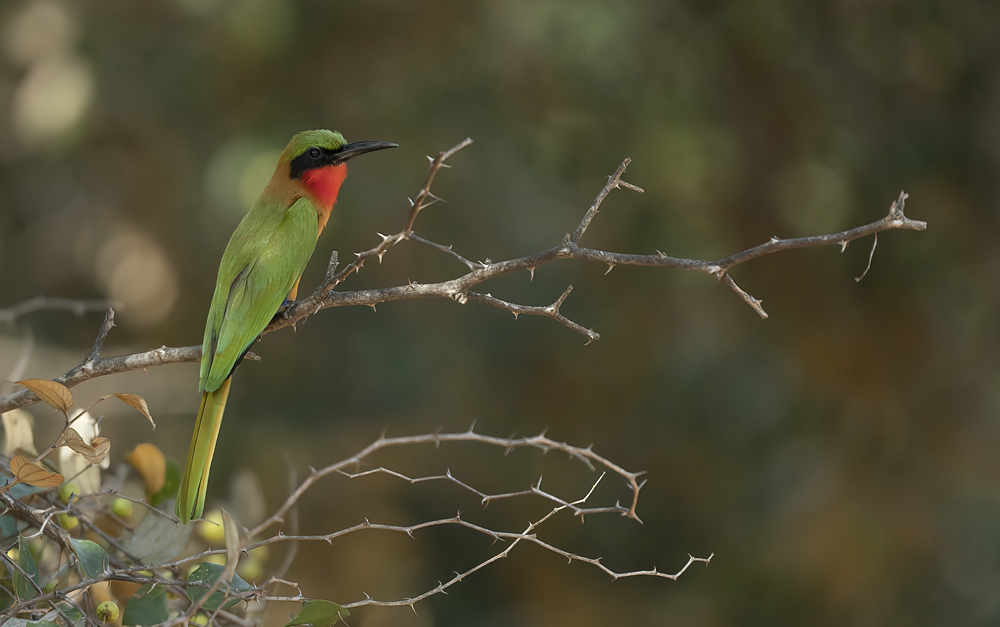
Red-throated Bee-eater Merops bullocki Mole National Park, Savannah Region, Ghana, 16 November 2019 (Dick Forsman).
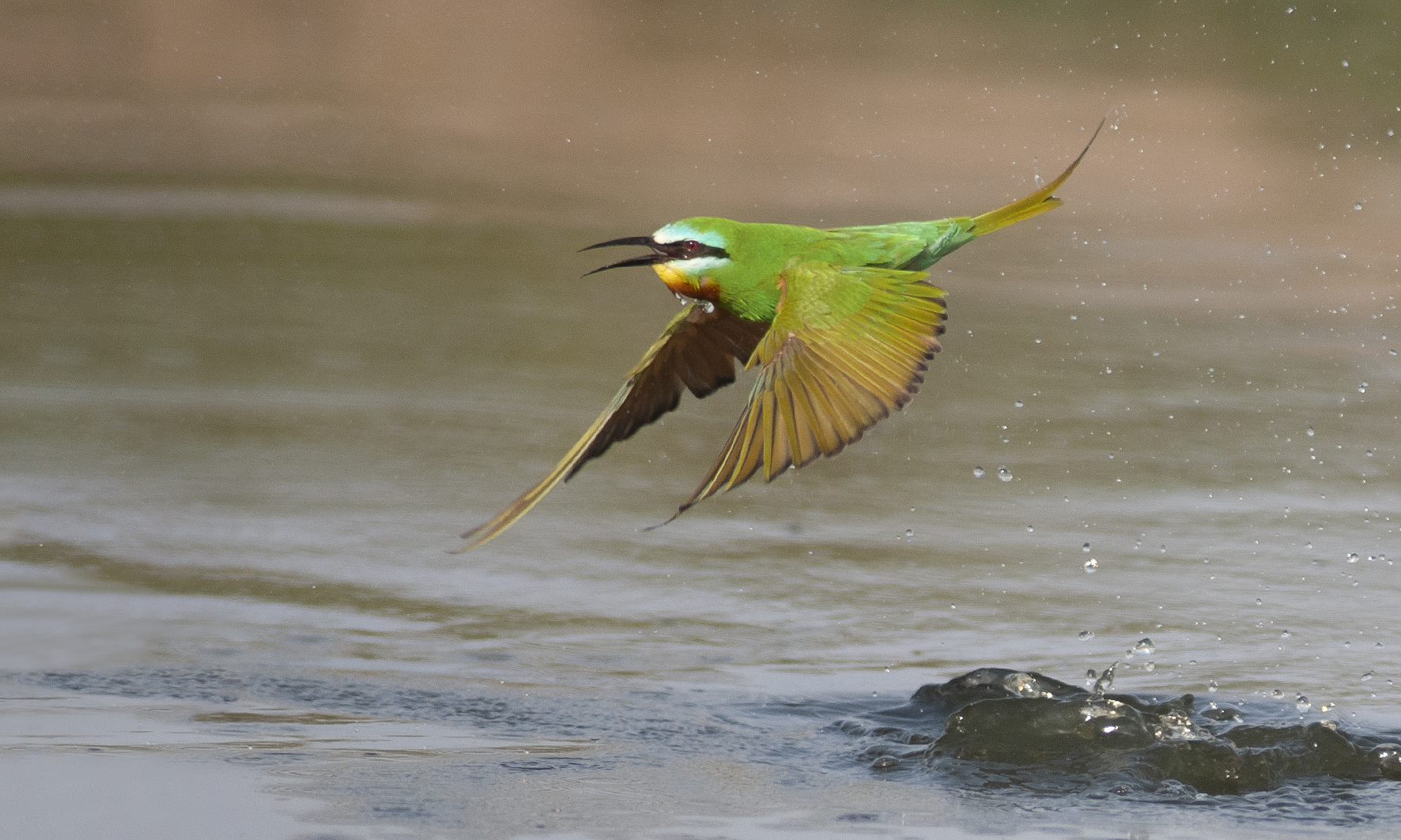
Blue-cheeked Bee-eater Merops persicus Sohar, Al Batinah, Oman, 14 April 2010 (René Pop).
Red-throated Bee-eaters Merops bulocki Mole National Park, Savannah region, Ghana, 09:33, 14 November 2019 (Magnus Robb). Excited calls of several individuals perched near a colony. Background: Red-eyed Dove Streptopelia semitorquata and Vinaceous Dove S vinacea. 191114.MR.093322.01
Blue-cheeked Bee-eater Merops persicus chrysocercus Derkaoua, Tafilalt, Morocco, 08:24, 30 March 2011 (Arnoud B van den Berg). Various calls by perched individuals. Background: House Sparrow Passer domesticus. 110330.AB.082400.21
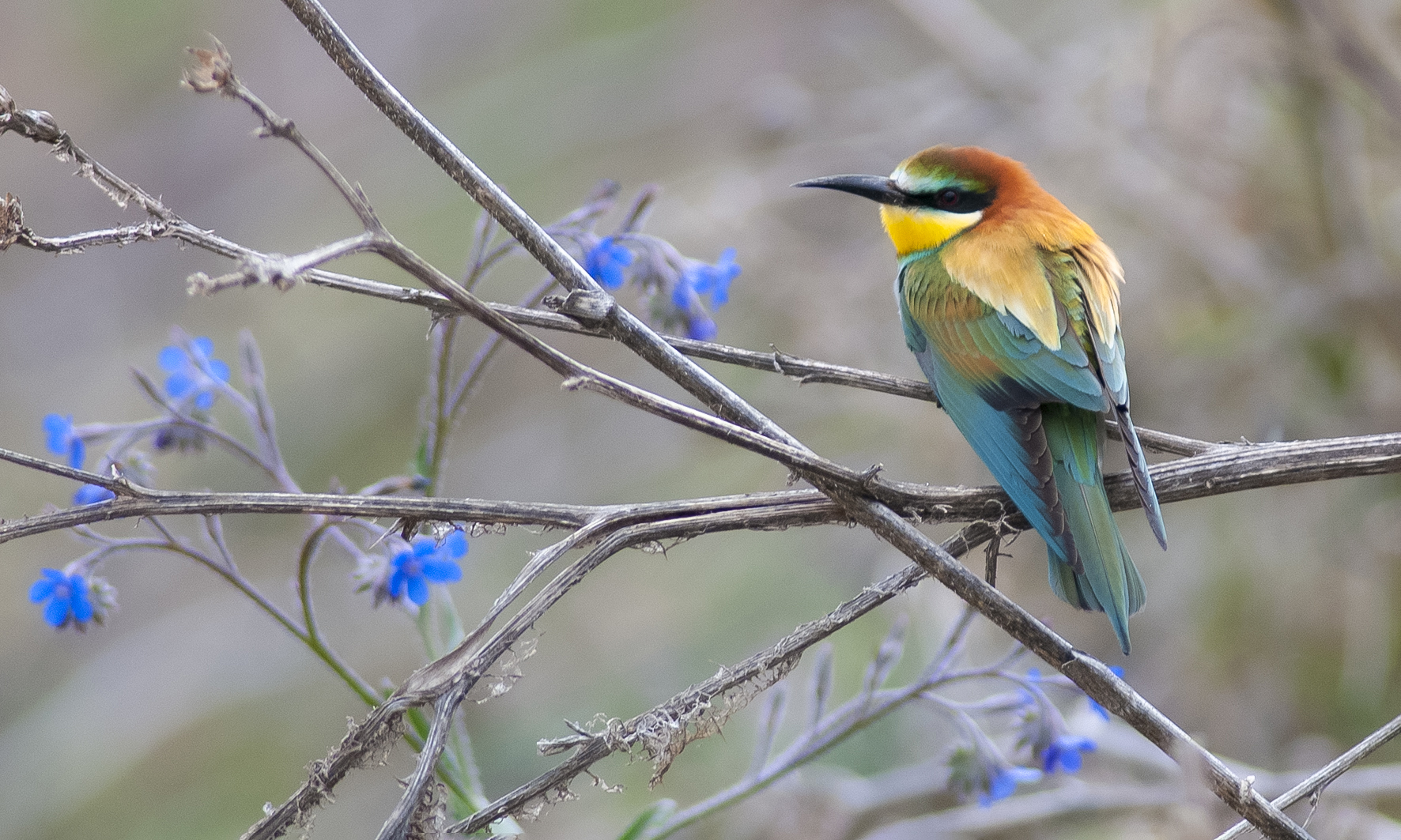
European Bee-eater Merops apiaster Sierra de Andujar, Jaén, Spain, 4 May 2012 (René Pop).
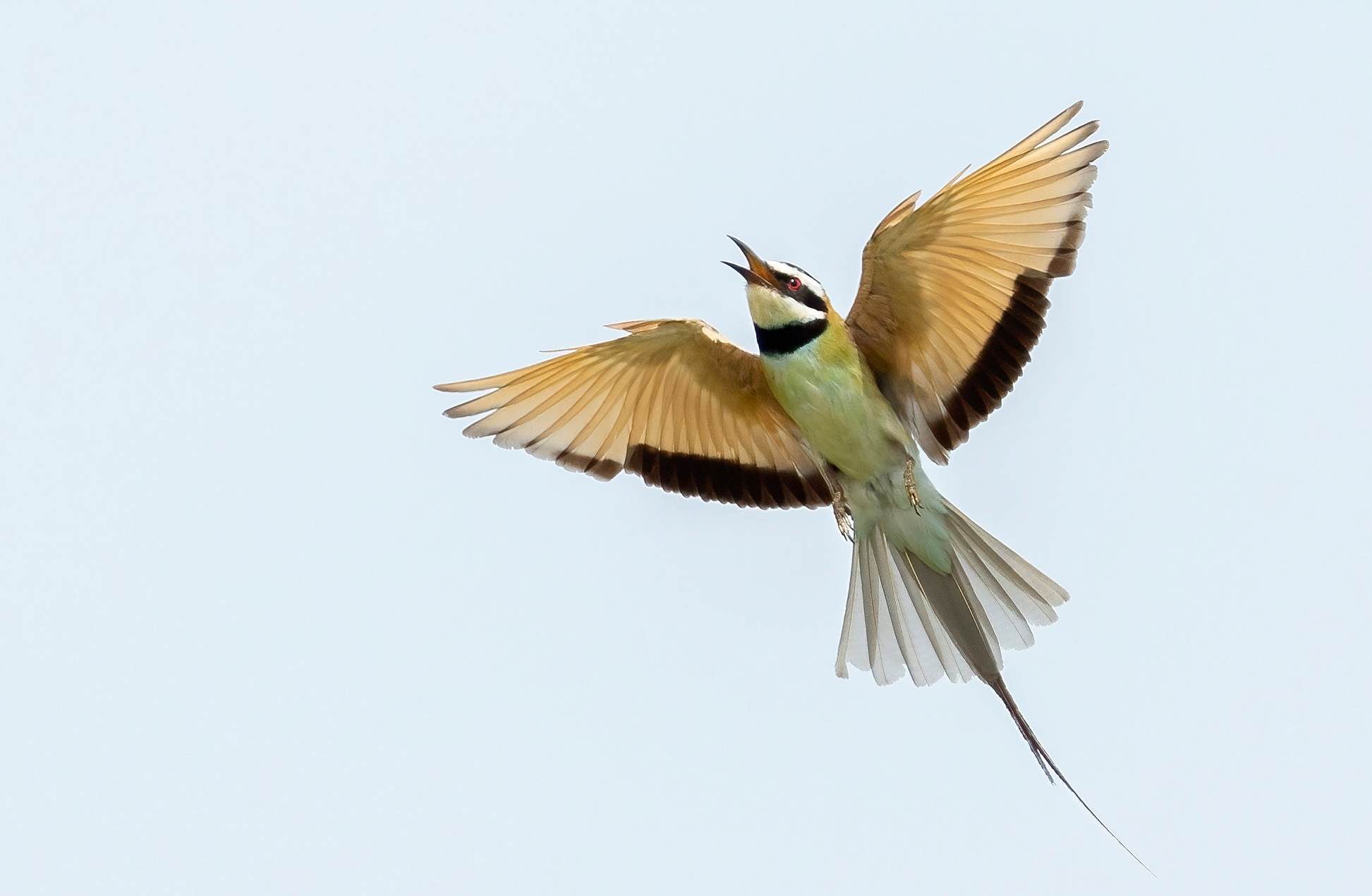
White-throated Bee-eater Merops albicollis Shai Hills, Ghana, 20 November 2019 (Dick Forsman).
European Bee-eater Merops apiaster Atanasovo Lake, Burgas, Bulgaria, 17:25, 21 September 2007 (Magnus Robb). Calls of a migrating flock.070921.MR.172552.01
White-throated Bee-eater Merops albicollis Mole National Park, Savannah region, Ghana, 09:33, 11 November 2019 (Magnus Robb). Calls of one or two migrating individuals. 191111.MR.093356.12
| Red-legged Partridge | Alectoris rufa |
| Pallid Swift | Apus pallidus |
| Common Swift | Apus apus |
| Little Ringed Plover | Charadrius dubius |
| Spotted Redshank | Tringa erythropus |
| White-throated Bee-eater | Merops albicollis |
| European Bee-eater | Merops apiaster |
| Blue-cheeked Bee-eater | Merops persicus |
| Red-throated Bee-eater | Merops bulocki |
| Iberian Magpie | Cyanopica cooki |
| Carrion Crow | Corvus corone |
| Eurasian Blue Tit | Cyanistes caeruleus |
| Great Tit | Parus major |
| European Crested Tit | Lophophanes cristatus |
| Cetti's Warbler | Cettia cetti |
| Long-tailed Tit | Aegithalos caudatus |
| Western Bonelli's Warbler | Phylloscopus bonelli |
| Willow Warbler | Phylloscopus trochilus |
| Eurasian Blackcap | Sylvia atricapilla |
| Eurasian Nuthatch | Sitta europaea |
| Short-toed Treecreeper | Certhia brachydactyla |
| African Thrush | Turdus pelios |
| Rock Sparrow | Petronia petronia |
| Tree Pipit | Anthus trivialis |
| Hawfinch | Coccothraustes coccothraustes |
| European Greenfinch | Chloris chloris |
| Common Linnet | Linaria cannabina |
| Glip Crossbill | Loxia curvirostra type C |
| Cirl Bunting | Emberiza cirlus |
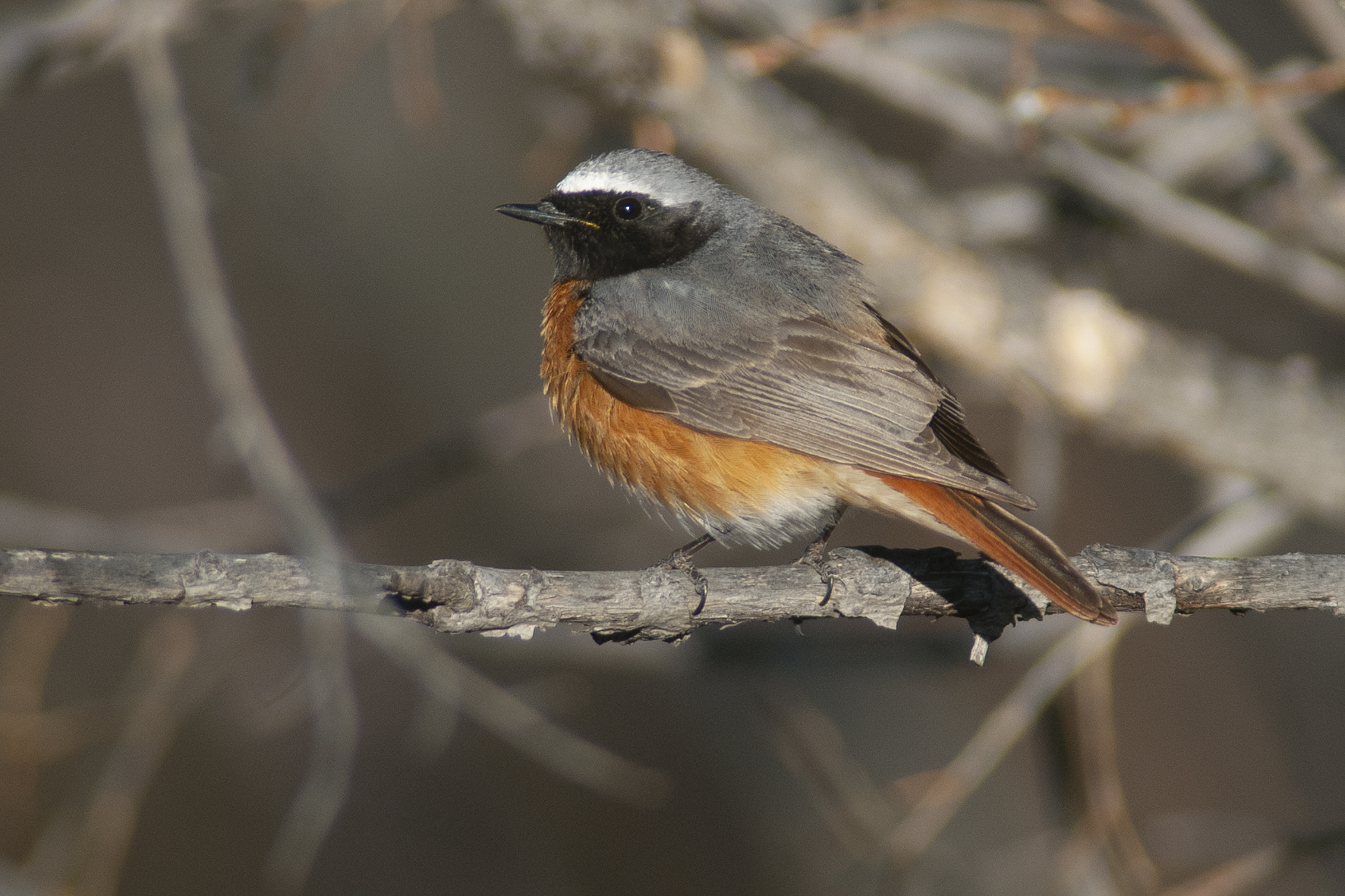
Common Redstart Phoenicurus phoenicurus phoenicurus Jalman Meadows, Tuv Aimag, Mongolia, 26 May 2008 (René Pop).
In summary, the structure of Common Redstart song has a small diagnostic fanfare followed by a short stream of imitations. It is discontinuous with about nine songs per minute. If you don’t pay attention to the structure, it could sound like a Common Chaffinch, or due to the mimicry it might sound momentarily like every other bird it has met. Much of this also applies to Ehrenberg’s Redstart P p samamisicus, but you can’t rely on fanfares to identify it, and there is also a tiny little feature that it usually possesses, which is rare in Common Redstart.
Ehrenberg’s Redstart P p samamisicus
As a musician I used to be in a group called Al Farabi, which played traditional music from various parts of the former Ottoman empire. Music of those traditions typically begins with an improvisation called a taksim, which can be anything from a few seconds to several minutes long. Well, if I may exaggerate slightly, Ehrenberg’s Redstart has a similar Oriental touch to its song.
Playing with stereotypes for a moment, while male Common Redstarts herald their dame with the same kind of fanfare each time, Ehrenberg’s have a much greater variety of opening lines, perhaps one for each of the ladies in their harem. I don’t know if they are actually any more polygamous than their western and northern counterparts, but their taksims are certainly more variable.
When I first heard Ehrenberg’s Redstarts 20 years ago I noticed that a fanfare, more often than not, was missing. Here is the first male I recorded. Of the 21 songs in this recording, only six have what I would then have recognised as a fanfare at the start, resembling those of the nominate subspecies. By that I mean an assertive opening starting with a whistle, followed by a couple of notes of slightly harsher type. You can hear them at 0:46, 1:01, 1:14, 1:30, 1:45 and 2:28.
Unlike Common Redstart, around 20% of Ehrenberg’s songs have mimicry of another bird as their opening, eg, Krüper’s Nuthatch Sitta krueperi at 0:09 in the recording below. Other songs begin with a series of repeated notes, like a fanfare with the whistle left out. But if Common is your benchmark it may seem that a fanfare is almost always missing.
Ehrenberg’s Redstart Phoenicurus phoenicurus samamisicus Soğuksu Milli Park, Kızılcahamam, Turkey, 9 May 2001 (Magnus Robb). Song of a male. Background: Eurasian Hoopoe Upupa epops, Mistle Thrush Turdus viscivorus, Great Tit Parus major, Krüper’s Nuthatch Sitta krueperi, Short-toed Treecreeper Certhia brachydactyla, Common Chaffinch Fringilla coelebs and European Serin Serinus serinus. 01.018.MR.00248 & 00404.21
Another feature very typical of Ehrenberg’s Redstart songs is that they frequently have a subtle, tiny low-pitched gruff chatter at the start of their strophes, present in this recording at 1:07, 1:51, 2:22 and 2:35. You can be forgiven for missing it. I hope so anyway, since it was only 20 years after hearing my first Ehrenberg’s that this feature caught my attention. Ayé et al (2014), in a paper on Ehrenberg’s vocalisations in British Birds, may have been talking about the same feature when they pointed out that “heavily modulated or vibrating introductory notes appear to be diagnostic”. I did once hear something similar in a Common Redstart song from the UK, but I have not yet heard an Ehrenberg’s singing for any length of time that lacked it.
Let’s listen now to Ehrenberg’s Redstart from a different area, this time a picnic site beside a fountain in southern Turkey. Our second male also has the little gruff chatter preceding many of its strophes. You can hear it in the first three strophes starting at 0:01, 0:11, 0:22 and then 1:27 (just a hint), 1:40, 1:49, 2:10, 2:22, 2:42 and 2:56. The gruff chatter takes four different forms in this recording. As for the ‘fanfares’, here they tend to be fairly low-pitched and consist of 2-4 repetitions of a short, slightly buzzing note.
Ehrenberg’s Redstart Phoenicurus phoenicurus samamisicus Cevisli, Akseki, Turkey, 07:48, 14 May 2014 (Mark Constantine). Song of a male. Background: Green Woodpecker Picus viridis, Eurasian Jay Garrulus glandarius, Eurasian Blue Tit Cyanistes caeruleus, Great Tit Parus major, Eastern Bonelli’s Warbler Phylloscopus orientalis and Common Chaffinch Fringilla coelebs. 140514.MC.074800.02
Our third male is from northern Armenia. He has rather long gaps between strophes, probably because it was around lunchtime when I caught up with him, and he must have been singing since well before dawn. You can hear some gruff chatter preceding the strophes at 0:52 and 1:41. As for this bird’s ‘fanfares’, they are typical Ehrenberg’s: simple repetitions of a single short and rather low or medium-pitched note.
Ehrenberg’s Redstart Phoenicurus phoenicurus samamisicus Dilijan, Tavush, Armenia, 2 May 2011 (Magnus Robb). Song of a male. Background: Eurasian Jay Garrulus glandarius imitating a Tawny Owl Strix aluco, Eurasian Coal Tit Periparus ater, Eurasian Wren Nannus troglodytes, Common Blackbird Turdus merula, Eurasian Bullfinch Pyrrhula pyrrhula and European Goldfinch Carduelis carduelis. 110502.MR.125956.22
In mimicry, Ehrenberg’s Redstart is just as accomplished as its western cousins, the choice of sounds reflecting its more easterly distribution. Ehrenberg’s may imitate Red-breasted Flycatcher Ficedula parva (eg,at 2:05 in the recording above) or Common Rosefinch Erythrina erythrina (eg, 0:33) and our first male was notable for his mimicry of Krüper’s Nuthatch. The nuthatch’s distribution falls entirely within the breeding range of Ehrenberg’s, so mimicry of this species might be considered diagnostic.
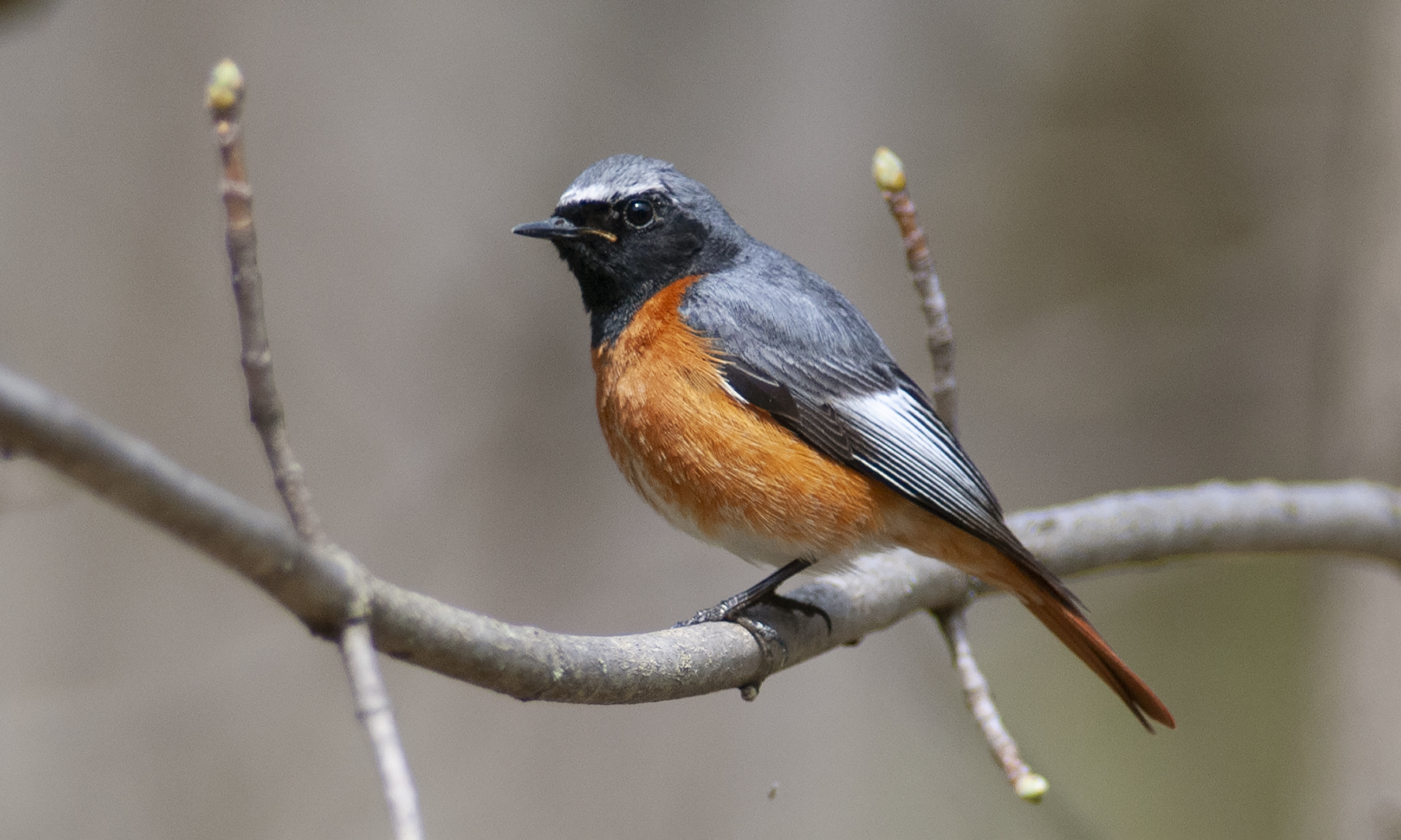
Ehrenberg’s Redstart Phoenicurus phoenicurus samamisicus Dilijan, Armenia, 2 May 2011 (René Pop).
Our Armenian male was courting a lady redstart, and this gave me an opportunity to record his intricate ‘ultra-crystallised’ courtship song. This is a continuous, whispering stream of song delivered at the entrance to a potential nest cavity. The gentleman here seems to be anxious to show how worldly and clever he is, with sounds picked up from a diverse array of other bird species, delivered in a constant stream lasting 14 seconds instead of the usual two to three.
Ehrenberg’s Redstart Phoenicurus phoenicurus samamisicus Dilijan, Tavush, Armenia, 2 May 2011 (Magnus Robb). ‘Ultra-crystallised’ song of a male courting a female at the entrance to a possible nest hole. Background: Common Cuckoo Cuculus canorus, Common Blackbird Turdus merula and Common Chaffinch Fringilla coelebs. 110502.MR.125744.22
On first hearing Ehrenberg’s Redstarts 20 years ago, I was struck by the fact that instead of the short, rising huit call familiar to me from Common Redstarts in Britain and the Netherlands, they had a flattish whistled heed as their most conspicuous call. This seemed such a simple and easily audible character that we would have mentioned it in ‘The Sound Approach to birding’ (Constantine & The Sound Approach 2006) as diagnostic for Ehrenberg’s, had we possessed a better recording.
A recent study in Dutch Birding (Martinez & Martin 2020) suggested otherwise. The paper represents a gentle revolution, using citizen science as the work sweeps together all Common Redstart calls from May to July in Xeno-canto’s collection and sorts them geographically.
Xeno-canto is a wonderful website that holds the second largest collection of bird sounds in the world and the only one mainly recorded by amateur sound recordists, with the same community curating and reviewing the identifications.
Xeno-canto has over a thousand recordings of Common Redstart available. To give scale the largest online collection at the Cornell Lab of Ornithology has 274, the British Library (third largest) has ten available online, while our collection currently has 206, including the ones that went online via this article.
In the paper Martinez & Martin found that whistles with little or no inflection also occur in nominate Common Redstarts in peninsular Italy, as well as parts of Kazakhstan and Russia. Most redstarts, however, have a Willow Warbler P trochilus-like call that starts off fairly flat and rises sharply towards the end, as in the example below. A typical example of Ehrenberg’s Redstart follows underneath it.
Common Redstart Phoenicurus phoenicurus phoenicurus Kildonan, Sutherland, Scotland, 28 June 2001 (Magnus Robb). Huit and plit calls of an adult female in typical combinations. Background: Song Thrush Turdus philomelos. 01.028.MR.01721.01
Ehrenberg’s Redstart Phoenicurus phoenicurus samamisicus Dilijan, Tavush, Armenia, 3 May 2011 (Magnus Robb). Heed and plit calls of an adult male. Background: Song Thrush Turdus philomelos. 110503.MR.073720.21
It came as a surprise to read in the paper the suggestion that Common Redstarts breeding in much of Iberia replace whistles with a wheezy, modulated vist that could not even be described as a whistle. Here is a recent example of this call type.
Common Redstart Phoenicurus phoenicurus phoenicurus Courelinhas, Coruche, Portugal, 10:22, 11 May 2021 (Magnus Robb). Vist and plit calls of an adult male. Background: Woodlark Lullula arborea and Common Chaffinch Fringilla coelebs. 210511.MR.102234.11
Now that I know where my nearest territories are this year, it will be interesting to explore more of Common Redstart’s vocabulary as this season unfolds. Besides understanding better how they use their vist call, I’d like to learn more of the obscure calls in their repertoire, as one of them could be particularly useful. At the time of writing, no nocturnal flight call for Common or Ehrenberg’s Redstart has been identified. Given that Black Redstart P ochruros has one, these close relatives surely have them too. Perhaps they are similar enough to the highly variable European Pied Flycatcher Ficedula hypoleuca or some other species migrating at the same season that we have been screening them out. I for one am making a serious effort to unscreen them. Now if you’ll just let me get back to my nocmig, Mark. Over to you…
Thanks Magnus. It’s difficult to see from Martinez & Martin’s paper how they dealt with the extensive repertoire of Common Redstart, and the variations according to behaviour and context. One of my favourite books, Birds in a Cage by Derek Niemann (2013) tells of several British ornithologists who spent most of World War 2 together as prisoners of war. They spent several years at Eichstätt, Bavaria, an old German barracks set in a very rich area for breeding birds. Among them was John Buxton, who studied breeding of Common Redstart at the camp from 1941 to 1944. His observations during the war formed the core of a New Naturalist title published almost a decade later, The Redstart (Buxton 1950). Buxton mentioned many different calls given during the breeding season, and his detailed observations on some of them are also described in a BB paper (Buxton 1945).
Is the lack of information on other calls in Martinez & Martin’s paper important? Maybe. Why? Let me explain. I have written many times about the debt I owe to Peter Grant who set the standards that we in The Sound Approach try to live up to. Well, sometimes he could make a mistake…
Mo and I were birding with him in Christchurch up the road in Dorset, England one August, light years ago, when he pointed out in a leafy tree the calls of a Siberian Chiffchaff P tristis, a flat short call known as the lost chick call. Now that’s a bit odd, as tristis typically arrive from October onwards.
Twenty years later, Killian recorded a family of Common Chiffchaffs P collybita in his garden and we realised that during their first weeks, young nominate chiffchaffs give the lost chick call before moving on to their better known sounds. Call development in many species was well documented by Thorpe, one of the fathers of bioacoustics (eg, 1961). So, Peter had heard a very young Common Chiffchaff. He couldn’t see the bird. Too leafy in August.
Back before the start of The Sound Approach I was recording Wood Warblers P sibilatrix and unwittingly had been standing by their nest. The nest alarm calls of male and female had a different length and inflection from each other, and I later confirmed this in BWP (Cramp 1992).
From these experiences a basic principle of The Sound Approach was formed that no bird has one song or one call. BWP lists fourteen vocalisations for Common Redstart and as we pointed out we don’t know its night migration sounds. I would suggest that the full redstart repertoire, taking into account both sexes and including young birds, will have nearer twenty different sounds.
Does this matter? No, I suspect that Martinez and Martin’s results are valid. However, it creates a landscape where nuance is dead and industrial techniques like this give the false impression that birds have one call and one song, and that is complete sound blindness. Back to you, Magnus.
Before moving on to Black Redstart, let’s remember that Common Redstart actually breeds in Africa, in the Maghreb. We have only one individual’s song to show, but what a strange song! It is similar in structure to the ones we have already considered, but the ‘fanfares’ at the start of each strophe sometimes constitute the entire song, eg, four out of the five strophes from 1:36 to 2:00. Most of the fanfares in this song, recognisable as such because the first note is longer and closer to a ‘whistle’, I suspect are in fact composed of Fulvous Babbler Argya fulva mimicry. However, as redstart’s mimicry is normally razor sharp, this doesn’t quite make the grade. All other strophes start with Eurasian Skylark Alauda arvensis mimicry, and in timbre this actually comes close to the gruff openings that are a special characteristic of Ehrenberg’s Redstart P p samamisicus. Common Redstarts from the Atlas Mountains are undoubtedly worthy of further investigation.
Common Redstart Phoenicurus phoenicurus phoenicurus near Azrou, Western Middle-Atlas, Morocco, 16:18, 12 June 2010 (Arnoud B van den Berg). Song of a male. Background: Common Firecrest Regulus ignicapilla, Moroccan Coal Tit Periparus ater atlas, Maghreb Treecreeper Certhia brachydactyla mauritanica, Common Blackbird Turdus merula and African Chaffinch Fringilla coelebs africana. 100612.AB.161800.01
As for mimicry, this individual has an impoverished repertoire and devotes only a small part of each strophe to this. Besides Eurasian Skylark it plagiarises sounds of Common Swift Apus apus, Great Spotted Woodpecker Dendrocopos major, Mahreb Treecreeper Certhia brachydactyla mauritanica, Eurasian Wren Nannus troglodytes, House Sparrow Passer domesticus, European Serin Serinus serinus and apparently very little else. I hope these lists don’t look too much like showing off, Mark…
No, they’re good. It’s fun seeing whether I agree. Let’s have a go at Black Redstarts now.
Black Redstart P ochruros
In BirdGuides’ comprehensive and excellent Focus on: Black Redstart (2020), David Callahan has some interesting observations: “To avoid ecological competition in areas where Black and Common Redstarts live very close to each other (such as in Central European villages), Black breeds an average of 19 days earlier than Common and specialises in caterpillars, spiders, woodlice and ant larvae, while Common concentrates on adult insects and beetle larvae. This ecological difference is also largely maintained in habitats where the two species don’t overlap.”
“The male advertises its desires by singing from often very high songposts – a pair I once observed regularly near East India Dock in East London nested in the ceiling of a ground-level car park, but the male would sing from nearby rooftops at least 11 storeys high.”
I remember the first time I properly heard Black Redstart singing. It was in spring 1988 on the roof of the local power station, a difficult site to access. I was scouting for a bird race on the Saturday.
Warm air has the effect of bending a sound upwards from the ground. So, beyond a certain distance from the source, a listener at ground level will be in a ‘sound shadow’. Singing at greater height allows the sound to travel further before being reflected or bent upwards at ground level (Catchpole & Slater 2008). Imagine a Black Redstart singing on the scree-covered slopes of the Alps on a warm day. A Common Redstart listening while foraging at the nearby treeline may be in the sound shadow and not even hear it.
It was Killian who planned and sketched out these plates and Richard Johnson who then painted these various Black Redstart taxa.
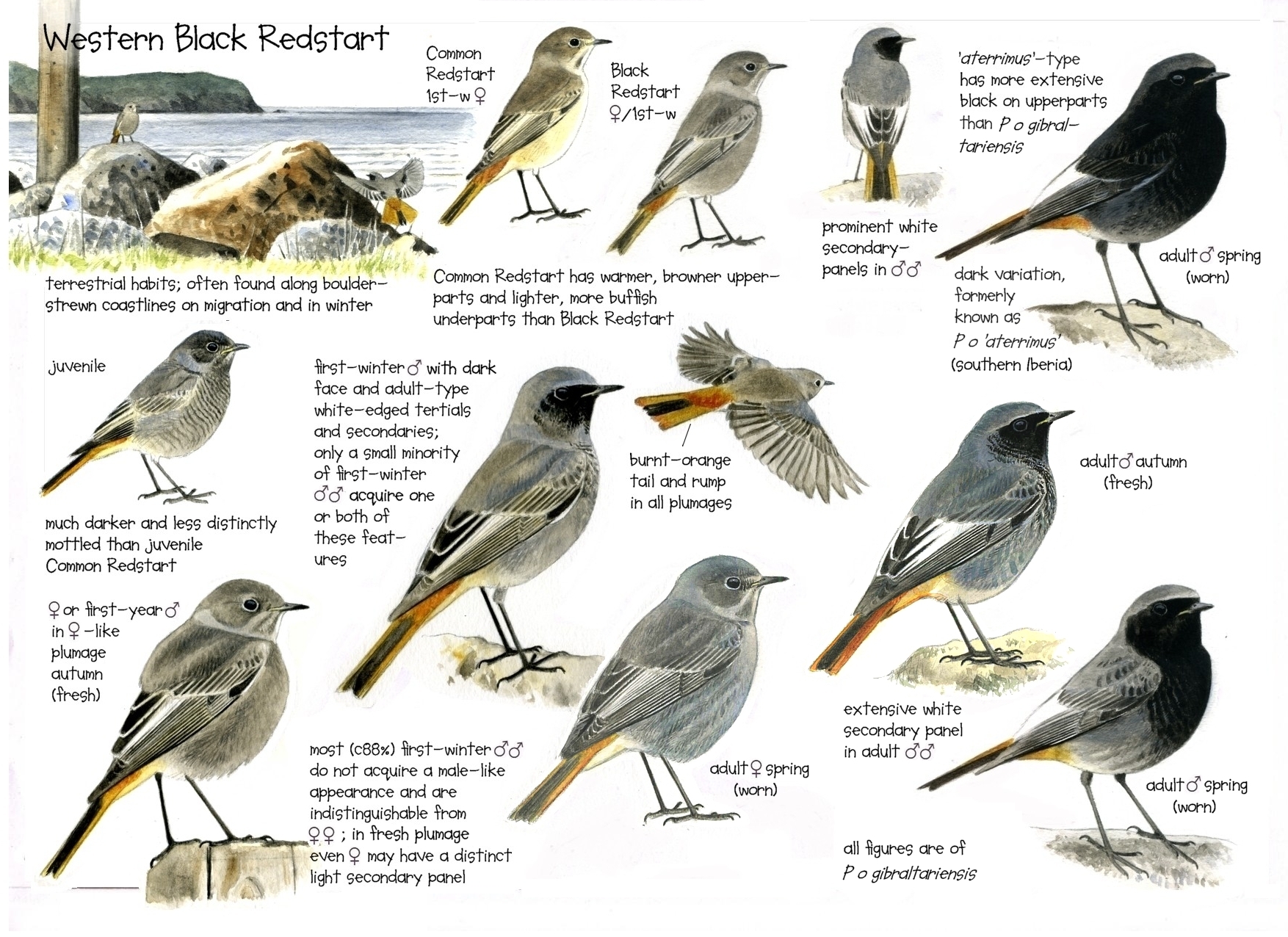
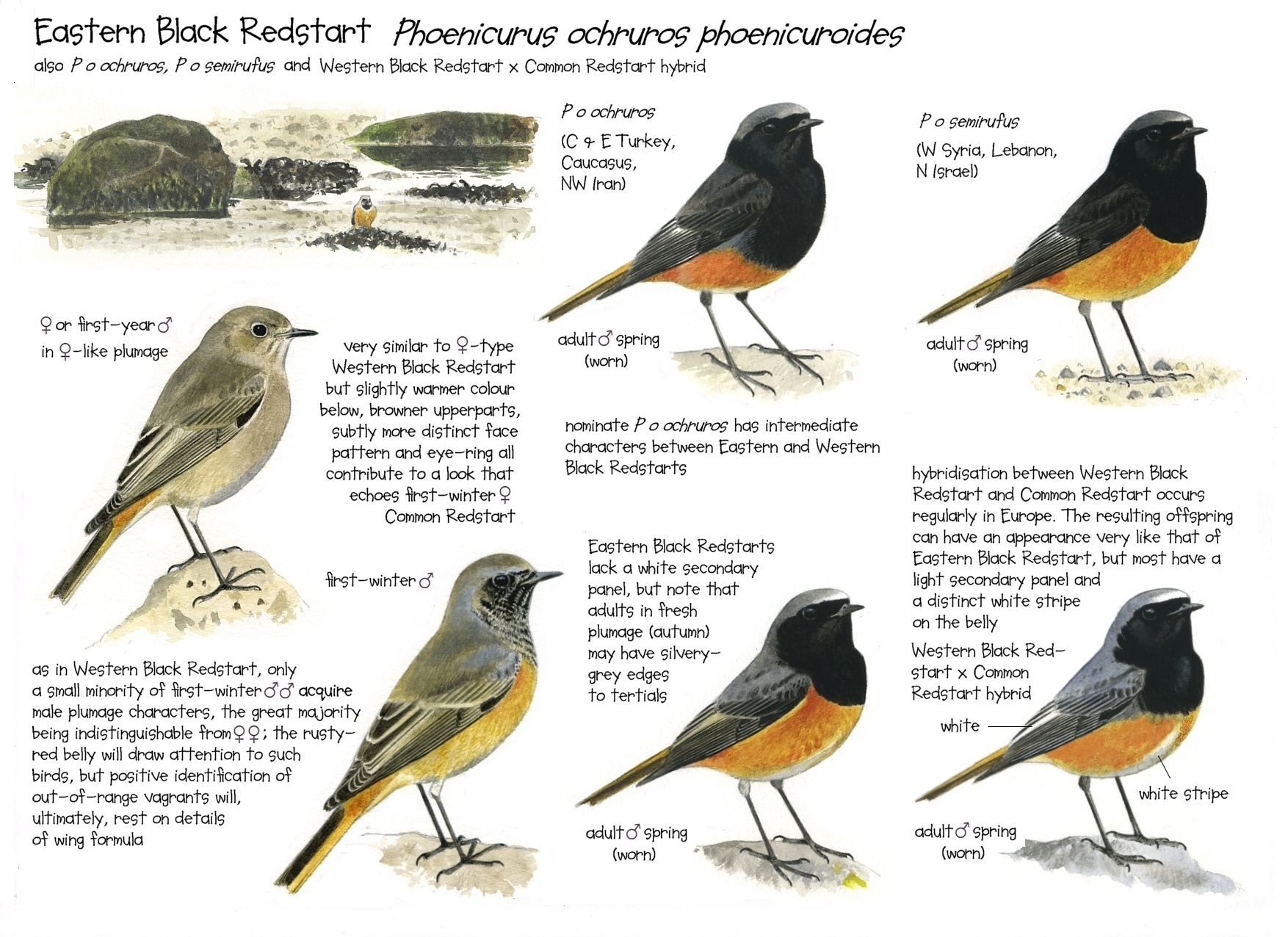
I like physics as it is reliable. Magnus is not so keen. He can be a bit ‘arty’, overly romantic and composerly. Let’s go back to him waxing lyrically about waterfalls and streams, all, according to him, found in the Black Redstart’s song…
I do think Black Redstarts have a bit of poetry in their songs, Mark. They contain a sound quite unlike that of any other bird I know, a rhythmically patterned white noise that reminds me of a chaotic little waterfall. I like to think they took their inspiration from the fast-flowing streams in their ‘classic’ habitat, rocky outcrops on mountain slopes. One characteristic of white noise is that it degrades very quickly with distance, sinking into the general background sound. When you are close, this part of the song can seem as loud as the rest but at a distance it simply disappears while the rest remains audible (not physics, you understand, just a puff steam). Probably Black Redstarts can tell the distance to their rivals more easily thanks to this part of the song.
Assuming that you can hear it, the hissing part immediately removes any possible confusion between Common and Black Redstart, should you be in one of those places where both species occur in close proximity.
Here is a Black Redstart 2450 m up on a mountain slope in southern Turkey with Caspian Snowcocks Tetraogallus caspius, Alpine Accentors Prunella collaris and White-winged Snowfinches Montifringilla nivalis. This individual belongs to the nominate subspecies ochruros, which has more rufous on its underparts than gibraltariensis of Europe. Song-wise, however, the two are extremely similar.
Caucasian Black Redstart Phoenicurus ochruros ochruros Demirkazık, Adana, Turkey, 06:32, 16 May 2014 (Magnus Robb). Song of a male. Background: Caspian Snowcock Tetraogallus caspius, Alpine Accentor Prunella collaris and White-winged Snowfinch Montifringilla nivalis. 140516.MR.063226.01
It might seem far-fetched to say that Black Redstart and Tawny Owl Strix aluco have similar songs, but with regard to overall structure this is true. Both have compound songs built up of three different components, the first of which can be delivered on its own and the second and third of which are almost always delivered together and in a fixed order. In Black Redstart, the first can be called the fanfare as it shares some characteristics with fanfares of Common Redstart. The second is the hissing section, and the third we can call the coda, a term borrowed from classical music which means, literally, the tail.
Fanfares of Black Redstart begin, often rather hesitantly, with a narrow-band sound, which can be a whistle or something less pure-sounding. There may be more than one of these, but very quickly some much harsher, broad-band sounds will follow, repeated often in an almost rattle-like configuration. In its general pattern, especially the rapidly expanding bandwidth, the fanfare shows some parallels to a (western) Common Redstart. Codas by contrast often start with a broad-band sound or a tone that sweeps across a range of 2 kHz or so in less than a tenth of a second. Some codas contain more invention than fanfares, to the point of becoming almost tuneful. Others are simpler, very similar to a fanfare but without the tentative, narrow-band opening. Each male seems to have up to four contrasting versions each of fanfare, hissing pattern and coda.
A fanfare can be delivered on its own or in a compound strophe where it is immediately followed by hissing and a coda. So, a bout of Black Redstart song will consist of ‘strophes’ that may be a fanfare on its own, a hiss-and-coda on its own, a compound fanfare-hiss-coda, or sometimes even longer strophes where the parts start to appear again in the same order. You can hear all except for this extended type in the following recording from the French Pyrenees.
Western Black Redstart Phoenicurus ochruros gibraltariensis Refuge de Glère, Hautes-Pyrénées, France, 05:28, 23 June 2002 (Arnoud B van den Berg). Song of a male. Background: another Black Redstart. 02.024.AB.01622.11
I would analyse the variation in this song roughly as follows, using F for fanfare, H for hiss and C for coda and numbering the different variants this bird has for each. The hissing variants, incidentally, are the least well-defined of the three. F1-H1-C1, F2-H2-C2, F1, F3-H2-C1, F1-H3-C2, F1, H4-C2, F1-H2-C1, F1-H2-C1, F1-H2-C2.
There is undoubtedly more to the ‘syntax’ of Black Redstart songs than I have described here, but now you know to listen for them, you can have fun tracking the different components and listening out for a couple of variants of each, the next time you hear a Black Redstart singing.
I have never identified a clear, unmistakeable imitation of another species in a fully crystallised song of Black Redstart. They probably exist but even if they do, mimicry in fully crystallised songs of this species is not really ‘a thing’. Plastic songs are a different story altogether, and they can have extensive mimicry. The best time to hear them is in the non-breeding season, especially in late winter.
My favourite example of Black Redstart mimicry was from a bird I recorded on a ruined house in an area of Portugal with a typical mid-Iberian range of species. I was probably looking for Spanish Imperial Eagles Aquila adalberti at the time, and the ruin was surrounded by scrubland and savannah-like ‘montado’ with Thekla’s Larks Galerida theklae and the like. This male’s whispered murmur includes imitations of Red-billed Chough Pyrrhocorax pyrrhocorax three times at 0:07-0:08 and a Yellowhammer Emberiza citrinella ‘pttt’ flight calls at 0:18, two species that were definitely not local. Most likely this was a male from the mountains of northern Spain that had wintered locally or even further south or west. The next day it was gone, presumably back to the land of choughs and Yellowhammers.
I believe I can also hear the following imitations in this Black Redstart’s plastic song: Common Buzzard Buteo buteo, Eurasian Magpie Pica pica, Eurasian Crested Tit Lophophanes cristatus, Dartford Warbler Sylvia undata, Common Blackbird Turdus merula, Alpine Accentor Prunella collaris, Tawny Pipit Anthus campestris, and Common Linnet Linaria cannabina. When it eventually delivers some songs that are closer to sounding crystallised, it strings them together almost without a break.
Western Black Redstart Phoenicurus ochruros gibraltariensis Rosmaninhal, Idanha-a-Nova, Portugal, 07:26, 8 March 2009 (Magnus Robb). Plastic song of a full adult. Background: Red-legged Partridge Alectoris rufa, Eurasian Collared Dove Streptopelia decaocto, Eurasian Hoopoe Upupa epops, Great Spotted Woodpecker Dendrocopos major, Iberian Magpie Cyanopica cooki, European Serin Serinus serinus and Corn Bunting Emberiza calandra. 090308.MR.072612.11
Black Redstart is not such a long-distance traveler as Common or Ehrenberg’s Redstarts. Their Western Palearctic (WP) breeding range extends from the Maghreb and Iberia north to southern Scandinavia and east to Moscow and Voronezh in Russia. Birds from cooler regions move south to the Mediterranean region for winter, with easternmost birds also moving into Arabia and the Horn of Africa. That may seem far but it’s only half the distance covered by Common Redstarts.
While actually migrating, Black Redstarts use a nocturnal flight call that Daniel Lopez-Velásco and I described only last autumn (Robb, Lopez-Velásco & The Sound Approach 2020). Since then, people have been picking up this call at many locations in Europe. Talk about sound blindness! It was there all along, hiding in plain earshot, sometimes even by day. Here is the same call used by a perched migrant after sunrise, the clearest example I have. We’ll come to the other, better known calls of Black Redstart further on.
Western Black Redstart Phoenicurus ochruros gibraltariensis Sagres, Vila do Bispo, Portugal, 4 November 2020 (Magnus Robb). Bit calls the same as nocturnal flight call, here used by a presumed migrant, perched on a rock early in the morning. Background: Spotless Starling Sturnus unicolor and Sardinian Warbler Sylvia melanocephala. 201104.MR.082034.00
Although this bird was probably from further afield, southern Iberia has particularly dark Black Redstarts formerly considered a subspecies, P o ‘aterrimus’. Now they are included in gibraltariensis, which occurs in most of the Western Palearctic. In mountains of Turkey, the Caucasus and Iran lives nominate ochrurus, ‘Caucasian Black Redstart’, with its orange lower belly and vent, and in the Levant there is semirufus, ‘Levant Black Redstart’, with its entire belly rufous and clearly separated from a black throat. For the latter no recordings are available, but ‘aterrimus’,gibraltariensis and ochrurus have very similar songs and I have noticed no differences. Further east, however, things get more interesting.
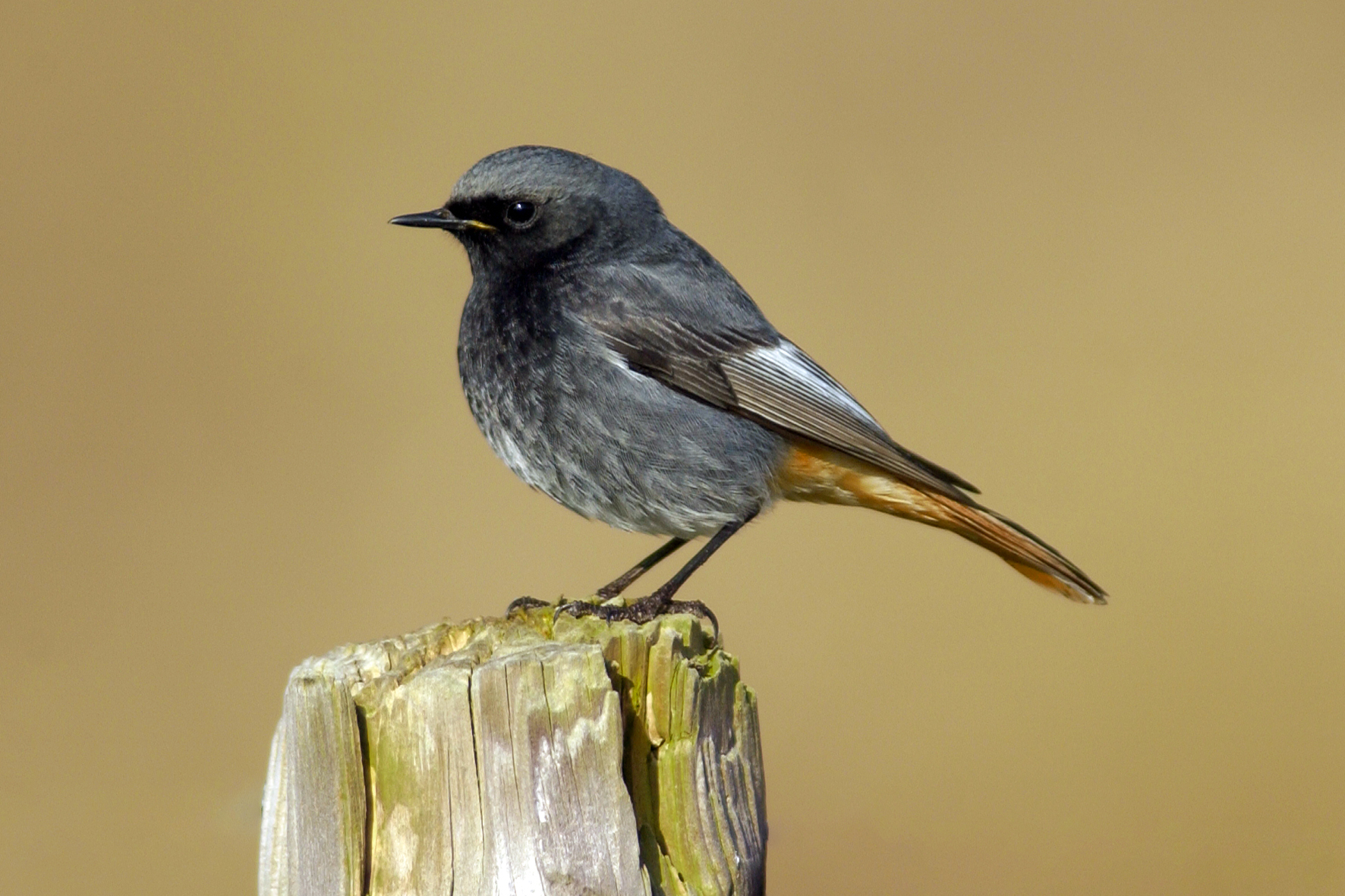
Black Redstart Phoenicurus ochruros gibraltariensis Texel, Noord-Holland, Netherlands, 23 March 2005 (René Pop).
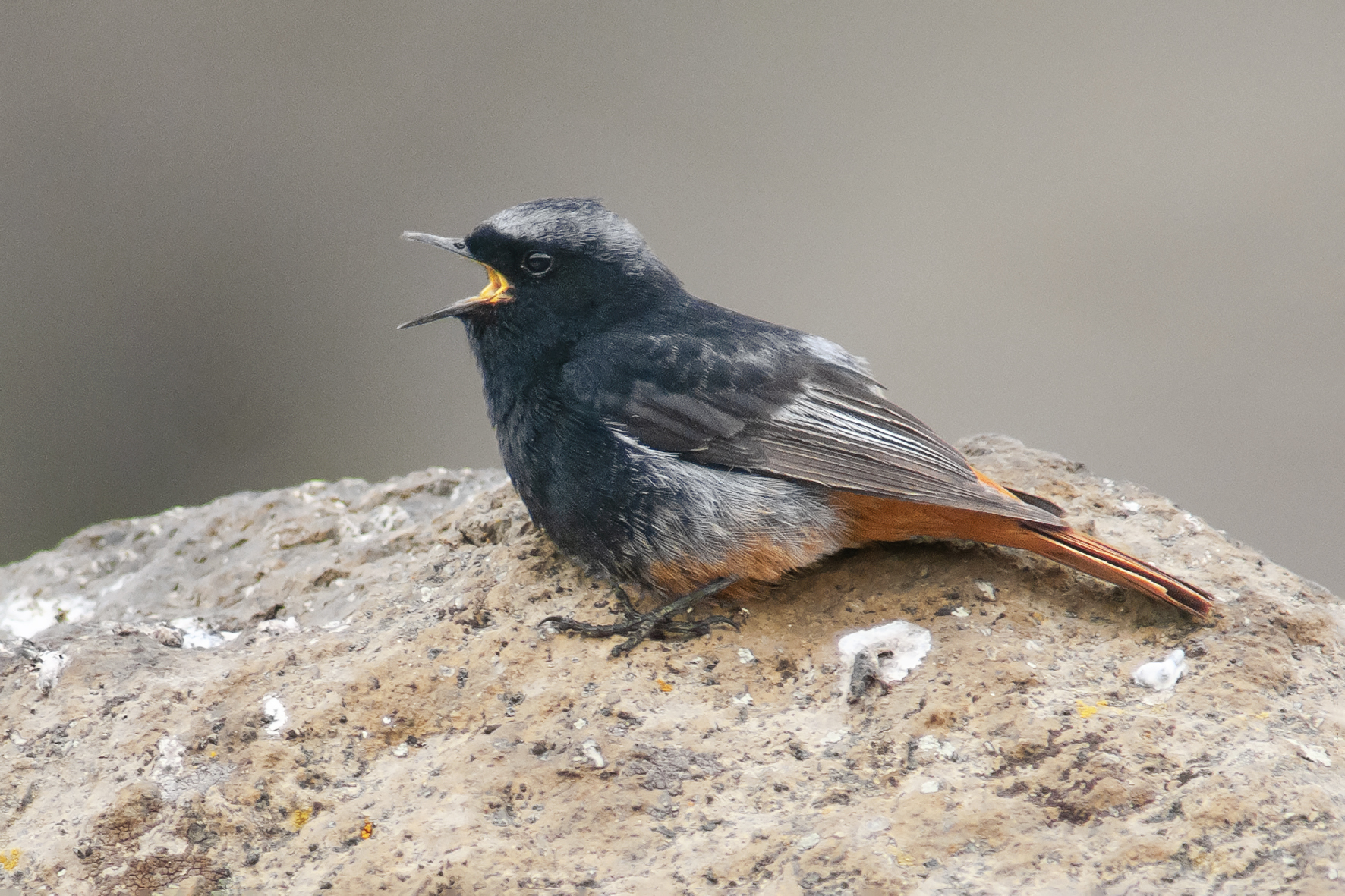
Caucasian Black Redstart Phoenicurus ochruros ochruros Mt Aragans, Aragatsotn, Armenia, 12 May 2011 (René Pop).
‘Eastern Black Redstart’ has come on many birders’ radar in the last couple of decades, since it can be prone to vagrancy, with records in late autumn or early winter most years in western Europe (van der Spek & Martinez 2018). Its range starts in eastern Turkmenistan and extends to China and Mongolia. There are two subspecies in the Eastern Palearctic, and both are currently still included in the one species with their Western Palearctic cousins. Phoenicuroides breeds further north and is the one that has reached Europe; rufiventris is a shorter distance migrant, presumably less prone to vagrancy.
Eastern Black Redstart P o phoenicuroides/ rufiventris
At this point a confession is required. I have very little direct experience of Eastern Black Redstart. I have seen them during a recording trip to India but if one ever sang I was distracted with some other Asiatic gem and failed to record it. The same can be said for my Sound Approach colleagues. Fortunately, Xeno-canto has a good number of examples, and two friends, Hannu Jännes and Ralph Martin, kindly shared several more. Between these sources I have listened to enough songs of phoenicuroides and rufiventris to notice a difference from all the gibraltariensis and ochruros songs in our own collection.
Without further ado, it’s this. Fanfares and codas in the Eastern Palearctic have a strong tendency to end on an upbeat, an emphatic final note. The fact that both fanfare and coda share the emphatic endings in Eastern suggests a common origin for both of these song components, which only really differ in the way they start. Indeed, one can occasionally hear a fanfare that appears – stripped of its hesitant opening – as a coda later in the same song, or vice versa. This applies to all Black Redstarts, not just Eastern.
Here is one of Hannu’s recordings, from Ladakh, where it is phoenicuroides that breeds (Rasmussen & Anderton 2012); the upbeat at the end of the fanfare is the loudest moment in these compound songs. I hear the same thing in 10 of the 14 songs of phoenicuroides and all 6 of rufiventris on Xeno-canto.
Eastern Black Redstart Phoenicurus ochruros phoenicuroides Hemis National Park, Ladakh, India, 18 September 2014 (Hannu Jännes). Song of a male. A two minute silence from 0:34 has been cut down to a few seconds. Background: Chukar Partridge Alectoris chukar.
In this recording two other features are noteworthy. One is that the frequency range extends lower that in most Black Redstarts from Europe, well below 2 kHz in some of the codas. Nicolas Martinez (pers comm) has noticed that in phoenicuroides songs there are more melodious song elements given at low frequencies, ie, with the complete element having its fundamental below 3.5 kHz and melodious parts, not just trills, going far below 3 kHz.It is also noteworthy that in the above song the hissing sections have a simultaneous humming sound with a fundamental frequency around 1 kHz.
The other recording Hannu sent is from Xining, Qinghai, China, where it is rufiventris that breeds. It also has emphatic endings to the fanfare and the coda, but in this case modulated to give a buzzing timbre. This recording does not have particularly low-pitched elements.
Eastern Black Redstart Phoenicurus ochruros rufiventris Xining, Qinghai, China6 June 2009 (Hannu Jännes). Song of a male. Background: sparrow Passer.
Not every Eastern Black Redstart has clear emphatic endings to the fanfare and the coda in its songs. This one from Tajikistan, provided by Ralph Martin, doesn’t have it in the fanfare, and in the coda it puts and accent on the penultimate note. Conversely, Black Redstarts in the Western Palearctic can occasionally have a hint of this feature. For example, the first Black Redstart song from Turkey above had a fairly emphatic ending to the coda at 0:14. On the whole, though, this is something you can find much more strikingly in Black Redstarts from the Eastern Palearctic, and it deserves closer study.
Eastern Black Redstart Phoenicurus ochruros phoenicuroides Alaudinskoye Ozero, Chapdara, Tajikistan, 6 May 2018 (Ralph Martin). Song of a male. Background: Himalayan Snowcock Tetraogallus himalayensis and White-winged Grosbeak Mycerobas carnipes.
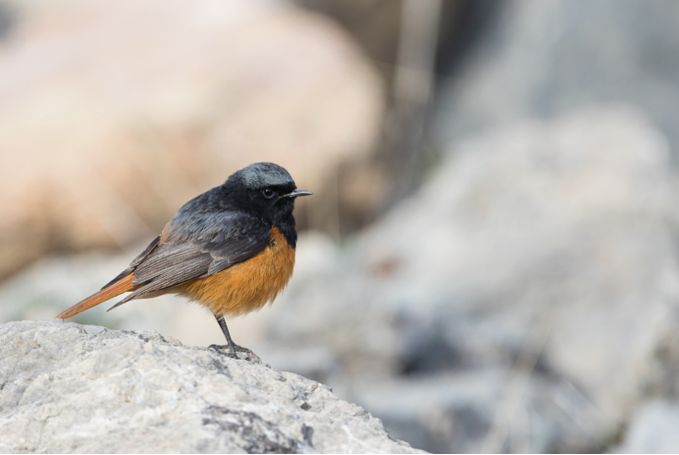
Eastern Black Redstart Phoenicurus ochruros phoenicuroides Alaudinskoye Ozero, Chapdara, Tajikistan, 6 May 2018 (Ralph Martin). The male in the recording above.
In our own collection, the only Eastern Black Redstart song we have is plastic song of a vagrant in the Netherlands, too lacking in structure to look for the features under discussion above. This recording includes at least one imitation of an Eastern Palearctic species: Yellow-browed Warbler P inornatus, unmistakeable at 1:29 (and also, less clearly, at 0:09 and 1:44). In addition, there is mimicry of Tree Pipit several times, and I believe, Eurasian Siskin Spinus spinus at 1:47.
Eastern Black Redstart Phoenicurus ochruros phoenicuroides Reiderwolder Polderdijk, Groningen, Netherlands, 10:01, 6 March 2018 (Arnoud B van den Berg). Imitative plastic song of a first-winter male. Background: Greater White-fronted Geese Anser albifrons, Barnacle Goose Branta leucopsis, Common Linnet Linaria cannabina and Common Reed Bunting Emberiza schoeniclus. 180306.AB.100100.22
It is impossible to resist the temptation to share another of Ralph Martin’s recordings, a beautiful plastic song he recorded in Tajikistan. This is also full of mimicry, with subjects I can recognise including Sulphur-bellied Warbler Phylloscopus griseolus, Red-breasted Flycatcher Ficedula parva, Brown Accentor Prunella fulvescens, Eastern Yellow Wagtail Motacilla tschutschensis, Tree Pipit Anthus trivialis, Common Rosefinch and White-winged Grosbeak Mycerobas carnipes. As you can probably tell, I love the nerdy challenge of identifying mimicry, but there is certainly more in there for anyone else who wants to have a go.
Eastern Black Redstart Phoenicurus ochruros phoenicuroides Iskanderkul, Sughd Province, Tajikistan, 5 May 2018 (Ralph Martin). Plastic or ‘ultracrystallised’ imitative song of a male. Background: Sulphur-bellied Warbler Phylloscopus griseolus.
It is a rare privilege to hear a vagrant Eastern Black Redstart singing, and Arnoud was lucky to get his recording. In Europe we are far more likely to hear calls. Black Redstarts in general have two that they use most often, a whistle and a tuc. Of these the tuc appears not to vary geographically. Here are examples of tuc calls in the Western and the Eastern Palearctic.
Western Black Redstart Phoenicurus ochruros gibraltariensis Sagres, Vila do Bispo, Portugal, 10:22, 2 December 2017 (Magnus Robb). Tuc calls of a wintering bird beside a small pool. Background: wingbeats of Iberian Magpie Cyanopica cooki and European Goldfinch Carduelis carduelis. 171202.MR.102230.10
Eastern Black Redstart Phoenicurus ochruros phoenicuroides Alaudinskoye Ozero, Chapdara, Tajikistan, 6 May 2018 (Ralph Martin). Tuc calls and song fragments of the same male as in the first recording from Tajikistan above. Background: Himalayan Snowcock Tetraogallus himalayensis, Red-billed Chough Pyrrhocorax pyrrhocorax, Hume’s Warbler Phylloscopus humei and White-winged Grosbeak Mycerobas carnipes.
Black Redstart tuc calls differ from Common Redstart plit calls in being lower-pitched and having a different timbre. Very short, broad-frequency calls like this can often be rather difficult to tell apart, but redstarts are quite doable. If you work with sonagrams a lot, you can learn to tell the difference between very short calls that rise sharply in pitch, such as the tic of a European Robin Erithacus rubecula, the plik of a Cetti’s Warbler Cettia cetti or the plit of Common Grasshopper Warbler Locustella naevia and those calls that descend rapidly in pitch, such as the tsip of Song Thrush Turdus philomelosor the tok of a Ring Ouzel T torquatus. Common Redstart is very clearly in the rising group, and if you listen carefully to its plit calls they resonate with the terminal high frequency. There is no such effect with Black Redstarts, which have a much more nondescript, low-pitched tuc.
Black Redstart’s equivalent to Common Redstart huit, heed and vist calls is a short, fairly high-pitched whistle that rises slightly in pitch, and can be transcribed as weet. Whereas Common huit calls range from 3 – 4.5kHz and the heed whistle found in Ehrenberg’s Redstart and some Common sits around 4.5 kHz, Black Redstarts are generally higher than this, around 5.5 – 6 kHz in gibraltariensis and ochrurus (Martinez & van der Spek in prep).
Whistle-tak is a call combination frequently found in both Common and Black Redstarts of all populations (where a generic tak is the plit of Common or the tuc of Black). A rule of thumb to separate whistle-tak calls of Common and Black is as follows. In Common (including Ehrenberg’s) the whistle, which can be huit, heed or vist, sounds relatively low-pitched compared to the plit, so the pitch rises from whistle to plit, whereas in Black of all subspecies the whistled weet sounds higher-pitched than the tuc, so the pitch falls from whistle to tuc.
Common Redstart Phoenicurus phoenicurus phoenicurus Kalenberg, Overijssel, Netherlands, 1 June 2005 (Magnus Robb). Huid and plit calls of a female. Background: Common Blackbird Turdus merula. 05.013.MR.11523.01
Western (‘Caucasian’) Black Redstart Phoenicurus ochruros ochruros Gergeti, Greater Caucasus, Georgia, 26 June 2005 (Arnoud B van den Berg). Weet and tuc calls of an adult female. Background: juvenile Black Redstart and House Sparrow Passer domesticus. 05.015.AB.05753.20
Nicolas Martinez and Vincent van der Spek (pers comm) have found geographical patterns in the weet whistles of Black Redstarts, which they will present in a paper currently in preparation. In short, they are finding that Eastern Black Redstarts have lower-pitched weet calls than Western Black Redstarts. Here are examples illustrating this difference.
Western Black Redstart Phoenicurus ochruros gibraltariensis Vallée d’Ossoue, Hautes-Pyrénées, France, 3 September 2007 (Arnoud B van den Berg). Weet calls. Background: Water Pipit Anthus spinoletta. 070903.AB.082723.21
Eastern Black Redstart Phoenicurus ochruros phoenicuroides Bharatpur, Rajasthan, India, 19 January 2002 (Magnus Robb). Weet calls of a male. Background: Rose-ringed Parakeet Psittacula krameri. 02.004.MR.02053.00
We have offered Nicolas and Vincent our own recordings and look forward to the full story in due course.
Hybrid Common x Black Redstarts
As our second plate illustrates, the main pitfall for identifying an Eastern Black Redstart in the Western Palearctic is a hybrid Common x Black Redstart. These are reported regularly from central Europe (Martinez et al 2019), and Arnoud recorded one in the town of Harlingen, Friesland, in June 1990, taking notes about its plumage, song and vocal behaviour.
In plumage, the Dutch bird was most like a male Common Redstart but with more black below the throat and onto the upper breast, and more rufous lower parts than in Common. Unlike Black subspecies, it had a clear white forehead, pale greyish upperparts, and greyish brown wings, just like Common. Despite the lack of genetic proof, based on plumage the concensus was that this had to be an F1 hybrid.
The bird was tricky to record, never continuing for long periods and remaining difficult to approach in a built-up area. It sang from roofs, antennas, chimneys and even from inside a ship under construction at the ‘Welgelegen’shipyard, ie, Black Redstart rather than Common Redstart habitat. According to Arnoud’s notes the song resembled that of a Black Redstart but without the scratchy, hissing bit typical for Black, and with the occasional strophe sounding more typical of Common. At one point it stayed still long enough for Arnoud to make a short recording.
Common x Black Redstart Phoenicurus phoenicurus x ochrurus Harlingen, Friesland, Netherlands, 2 June 1990 (Arnoud B van den Berg). Song of a hybrid. Background: House Sparrow Passer domesticus. 900602.AB.110000.01
The three songs in the recording have a structure that more closely resembles Common Redstart than Black Redstart, a short fanfare followed by a series of imitations. The first fanfare is like Common though faster than most nominate phoenicurus, while the second is indistinguishable from a Black Redstart fanfare. The imitations that follow include Western Bonelli’s Warbler Phylloscopus bonelli, possibly Eurasian Blue Tit Cyanistes caeruleus and certainly European Greenfinch Chloris chloris, European Goldfinch Carduelis carduelis and European Serin Serinus serinus.
Martinez et al (2019) collected literature, recordings and personal reports on hybrid redstarts and mixed singers and were able to describe some general patterns. Out of 55 individuals for which recordings or information was available, 67% sang like Black Redstarts, 22% gave either a mixed song or songs of both parents, and 9% were reported to sing like Common Redstarts. In other species pairs, like Common Nightingale Luscinia megarhynchos and Thrush Nightingale L luscinia or Melodious Warbler Hippolais polyglotta and Icterine Warbler H icterina, when their songs come into contact, one of the two dominates and the other adapts to sound more like it. Common Nightingale and Icterine Warbler are dominant in the above pairs (Constantine & The Sound Approach 2006). We suggest that Martinez has shown that Black Redstart is the dominant bird in this case.
Arnoud did not make any notes about the calls of the hybrid in Harlingen, but Martinez et al (2019) report hybrids commonly giving calls of both species.
In practice, if a Black Redstart with an orange belly sings crystallised song in Europe in spring, it is overwhelmingly likely to be a hybrid. Conversely, if you see a bird in late autumn or winter looking like an Eastern, it is likely to be the real deal. Hybrids and mixed singers are essentially a spring and summer phenomenon while Eastern turns up from October onwards, becoming diminishingly rare until spring (van der Spek & Martinez 2018).
This is the last of a series of ten articles. They were written in the hope they would be the backbone of a second edition of The Sound Approach to birding. There always seems to be so much more to learn. In conversation with Killian the other day, he pointed out how lucky we are to have a subject like birds as our interest, as he was sure birding was the elixir for eternal life.
Coming soon: The Sound Approach guide to waders.
Ayé, R, Martinez, N & Stalling, T 2014. The vocalisations of ‘Ehrenberg’s Redstart’. British Birds 107: 26-36.
Buxton, E J M 1945. On the nuptial displays of the redstart. British Birds 38: 282-287.
Buxton, J 1950. The Redstart. New Naturalist Monographs. London.
Callahan, D 2020. Focus on: Black Redstart. https://www.birdguides.com/articles/species-profiles/focus-on-black-redstart/
Catchpole, C K & Slater, P J B 2008.Bird song. Biological themes and variations. Second edition. Cambridge.
Comolet-Tirman, J 1994. Le chant imitatif du Rougequeue à front blanc (Phoenicurus phoenicurus): une étude en forêt de Fontainebleau, Seine-et-Marne, France. Nos Oiseaux 42, 267-277.
Constantine, M & The Sound Approach 2006. The Sound Approach to birding. Book with two audio CDs. Poole
Cramp, S (ed.) 1992. Handbook of the Birds of Europe, the Middle East and North Africa. Volume VI – Warblers. Oxford.
Hogner, S, Laskemoen, T, Lifjeld, J T, Porkert, J, Kleven, O, Albayrak, T, Kabasakal, B & Johnsen, A 2012. Deep sympatric mitochondrial divergence without reproductive isolation in the common redstart Phoenicurus phoenicurus. Ecology and Evolution. doi: 10.1002/ece3.398
Martinez, N, Nicolai, B & Spek, Vincent van der et al 2019. Redstart hybrids in Europe and North Africa. British Birds 112: 190-210.
Martinez, N & Martin, R 2020. Geographical variation in Common Redstart calls. Dutch Birding 42: 163-174.
Niemann, D 2013. Birds in a Cage. London.
Rasmussen, P C & Anderton, J C 2012. Birds of South Asia. The Ripley guide 2. Second edition. Barcelona.
Robb, M, Lopez-Velásco, D & The Sound Approach 2020. Nocturnal flight calls of Black Redstart: an unexpected discovery. https://soundapproach.co.uk/nocturnal-flight-calls-of-black-redstart-an-unexpected-discovery/
Sample, G 1996. Collins Field Guide: Bird songs and calls. Book and two audio CDs. London.
Sample, G 2006. Collins Field Guide: Wildlife Sounds of Britain & Ireland. Book and audio CD. London.
Sample, G 2010. Collins Bird Songs & Calls. Book and 3 CDs. London.
Schreur, G, Mayordomo, S & Langlois, D 2020. Fifty species in an hour: the remarkable mimicry of Common Redstart. BirdGuides. https://www.birdguides.com/articles/ornithology/fifty-species-in-an-hour-the-remarkable-mimicry-of-common-redstart/
Thomas, A 2020. RSPB guide to birdsong. London.
Thorpe, W H 1961. Bird-song. The biology of vocal communication and expression in birds. Cambridge monographs in experimental biology 12. London.
van der Spek, V & Martinez, N 2018. Identification and temporal distribution of hybrid redstarts and Eastern Black Redstart in Europe. Dutch Birding 40: 141-151.
Zendel, B R, & Alain, C 2012. Musicians experience less age-related decline in central auditory processing. Psychology and Aging, 27(2), 410–417. https://doi.org/10.1037/a0024816